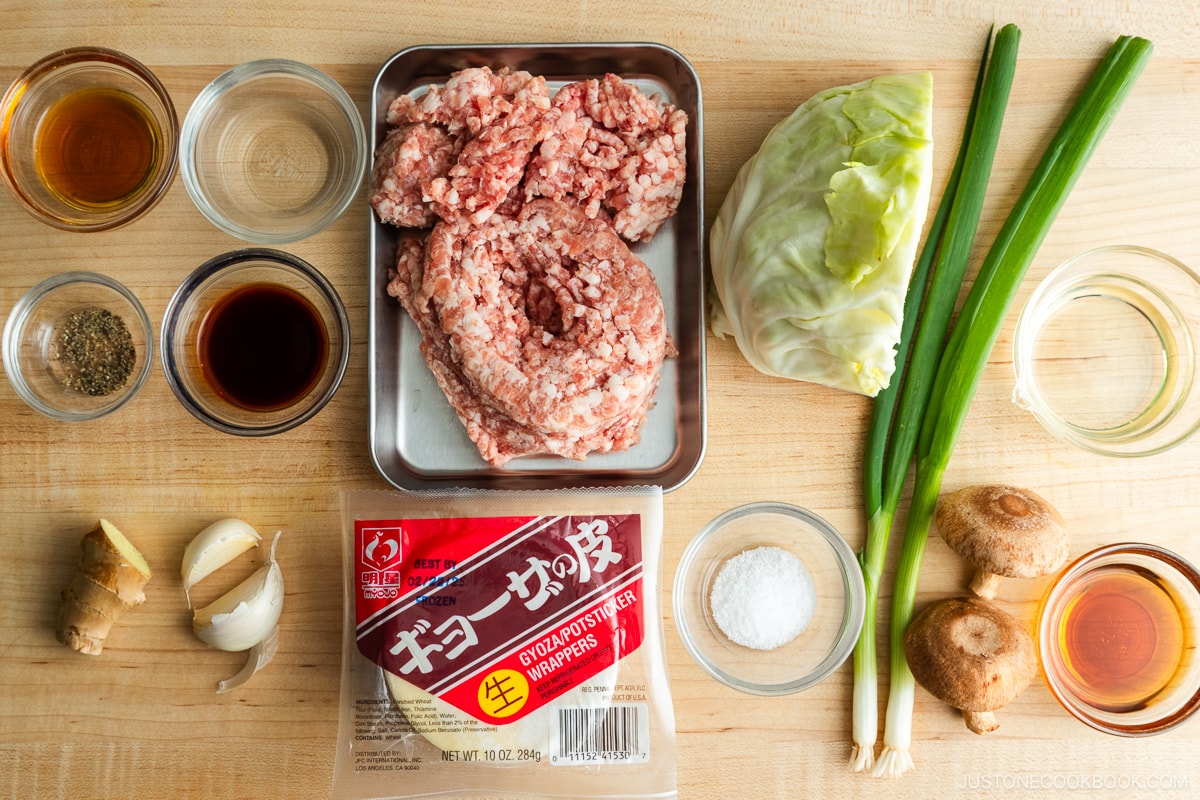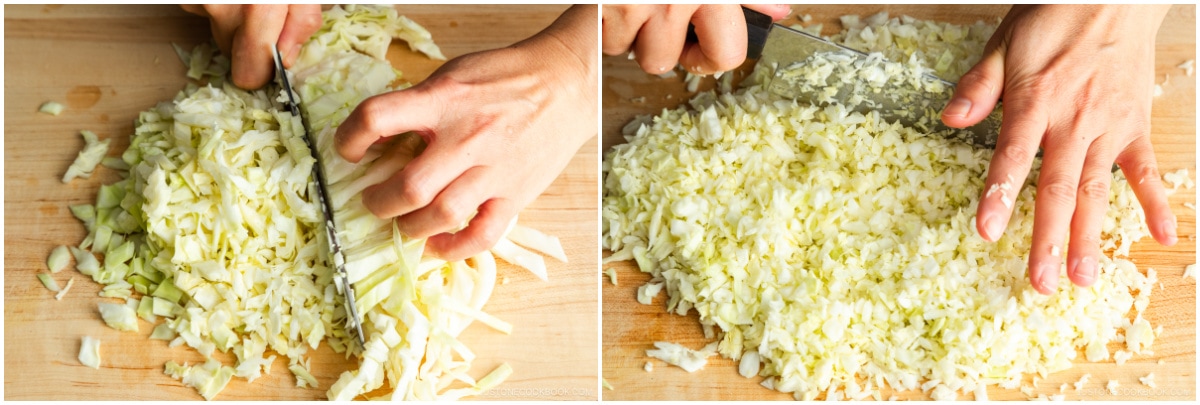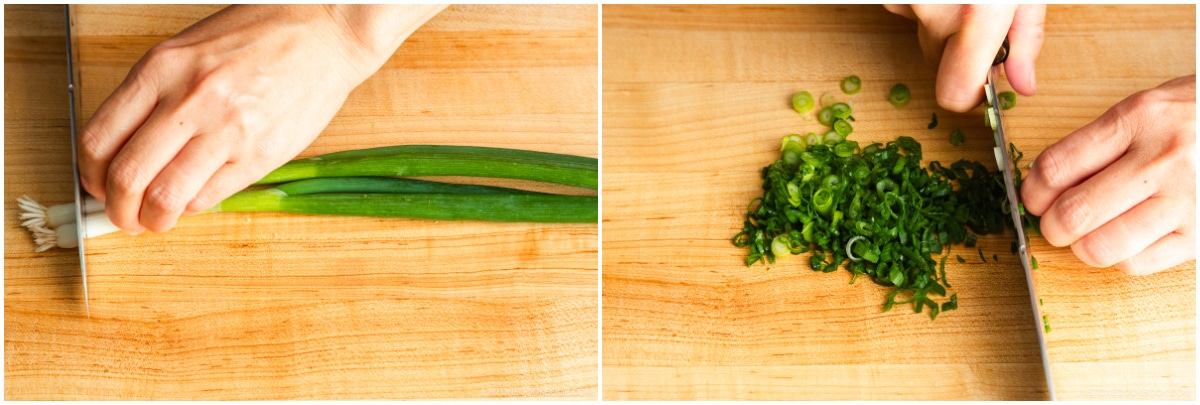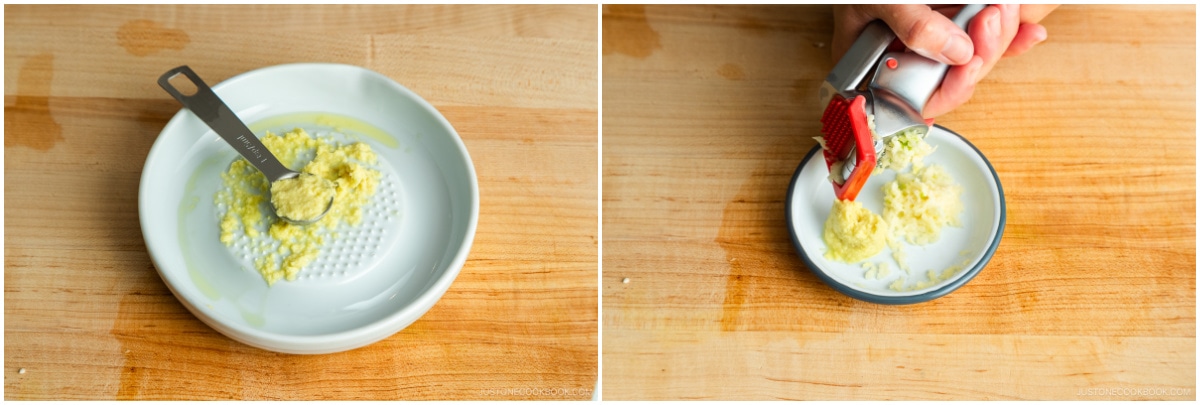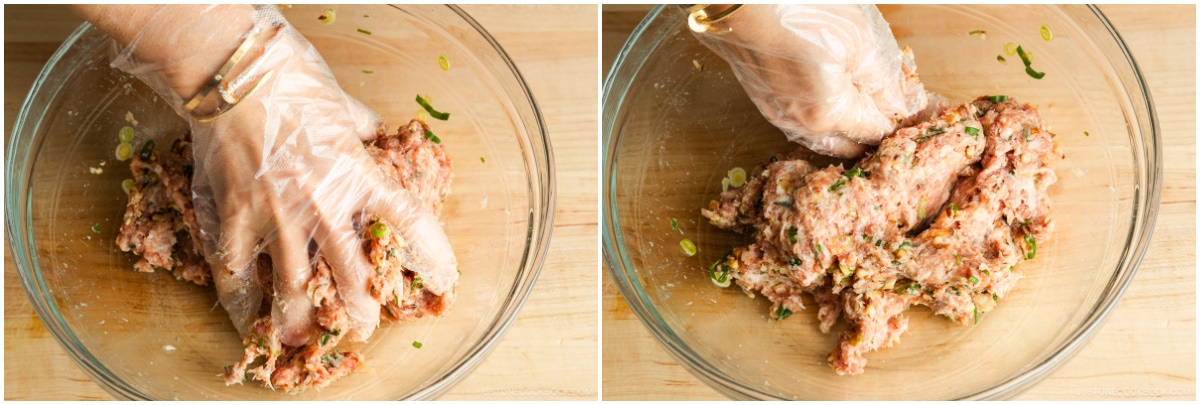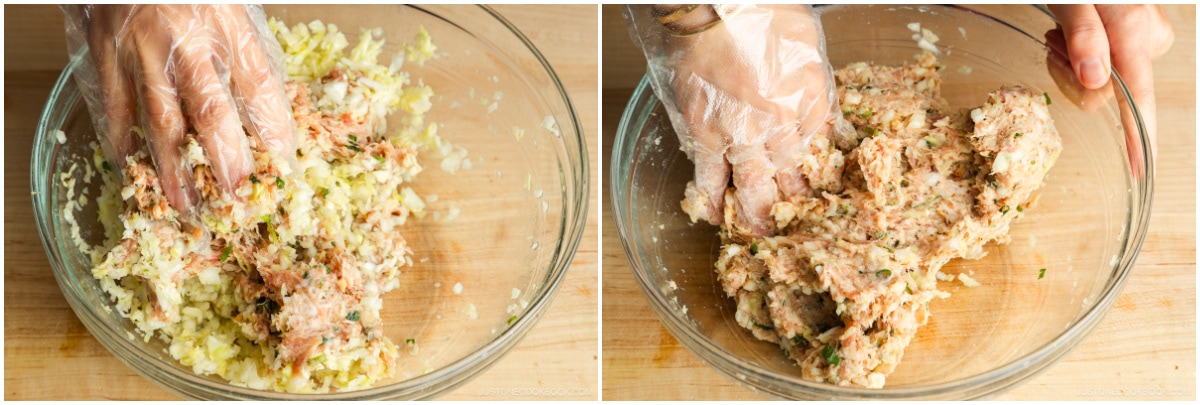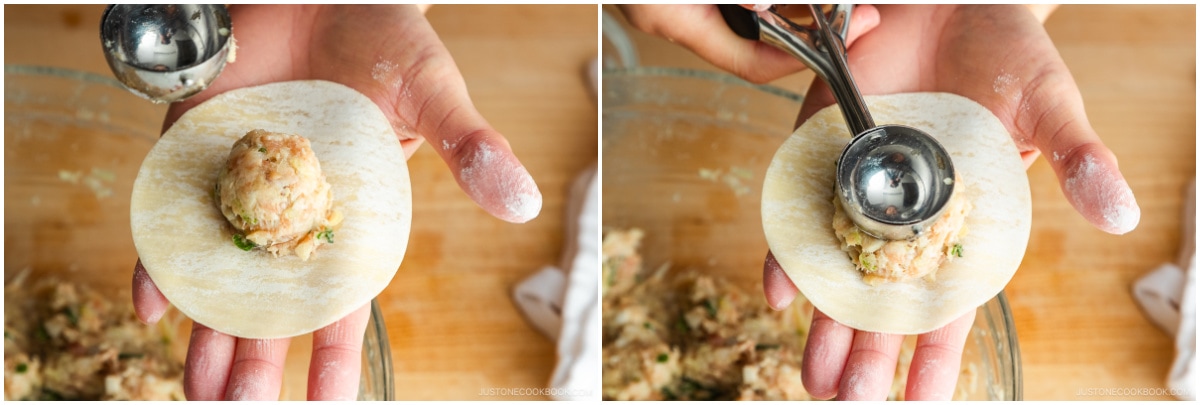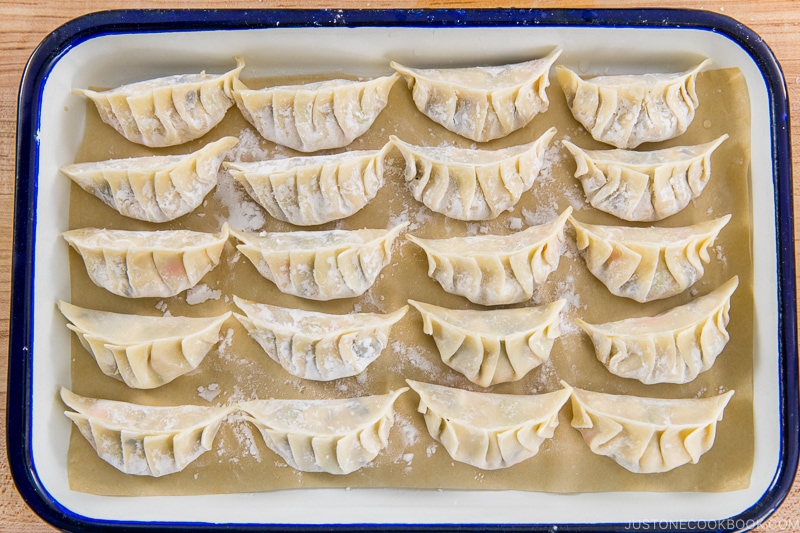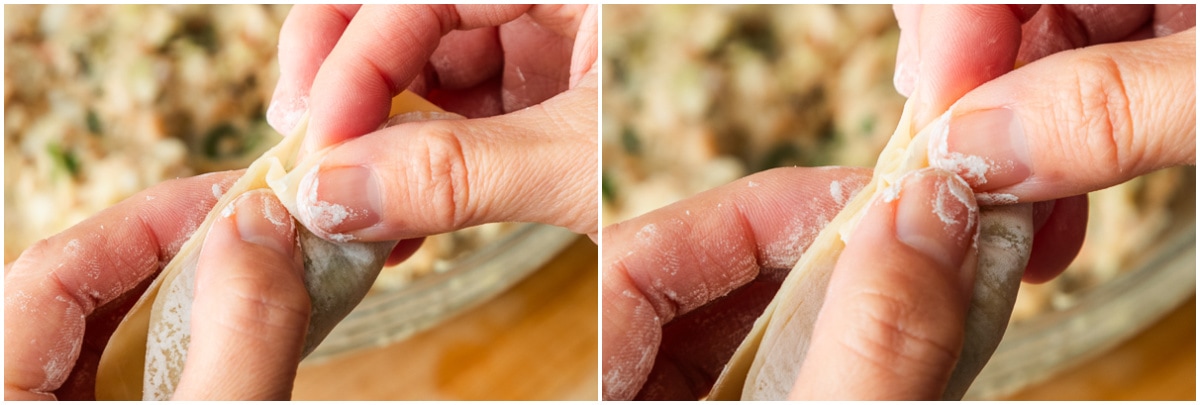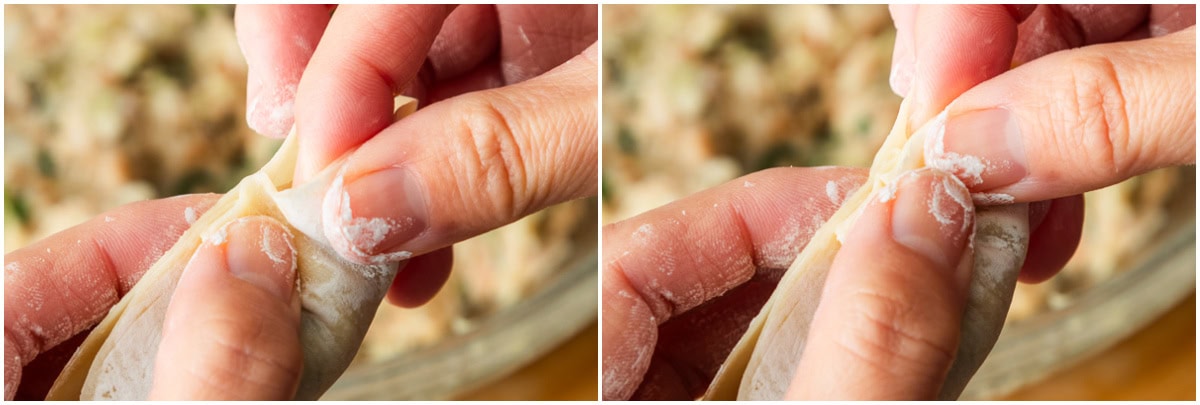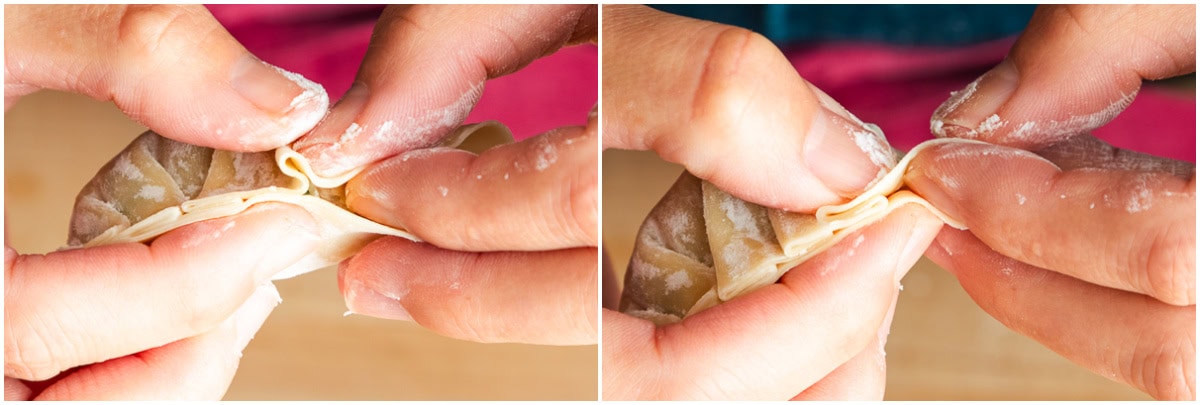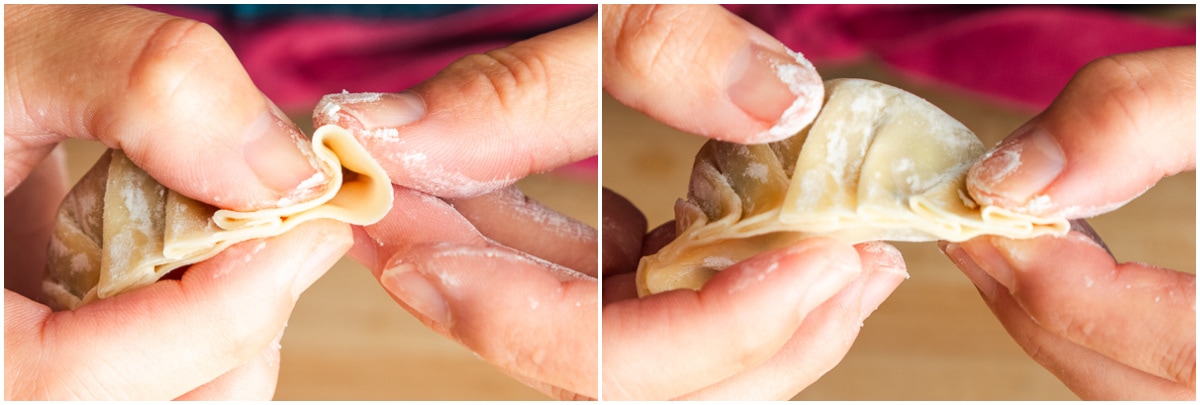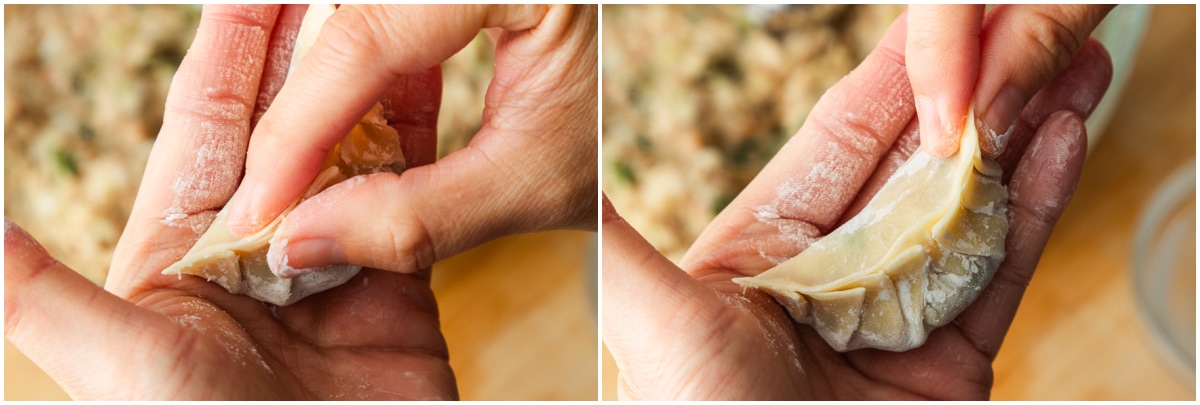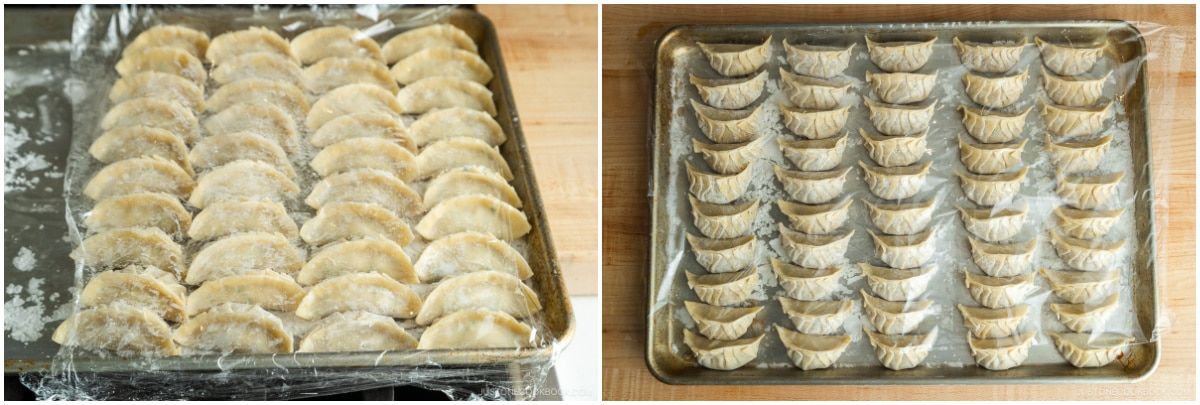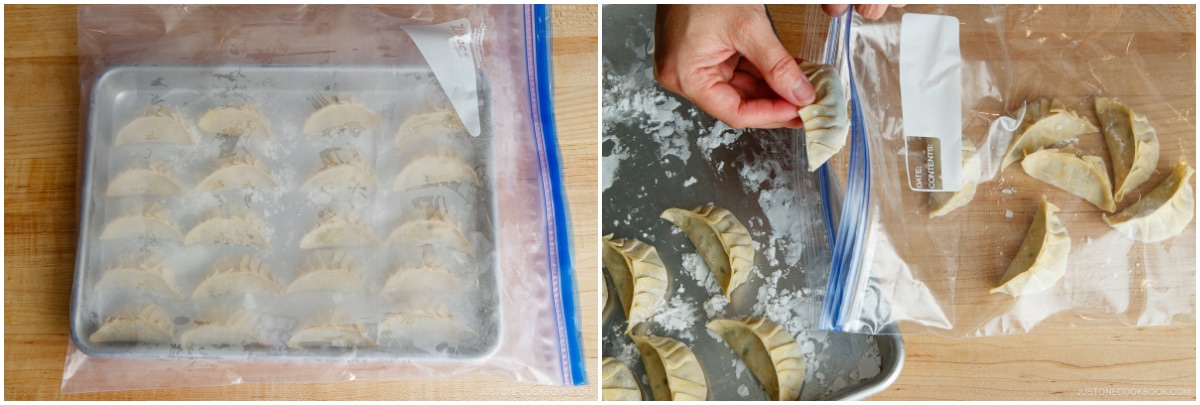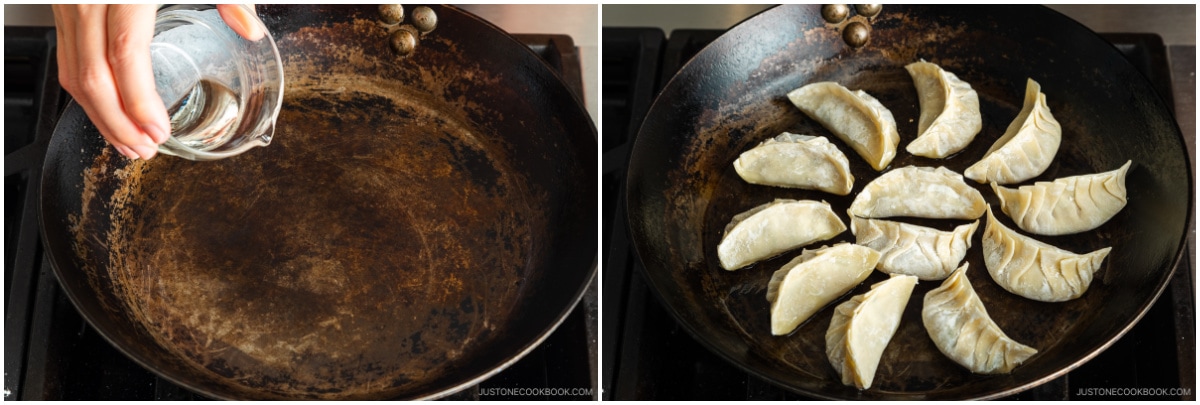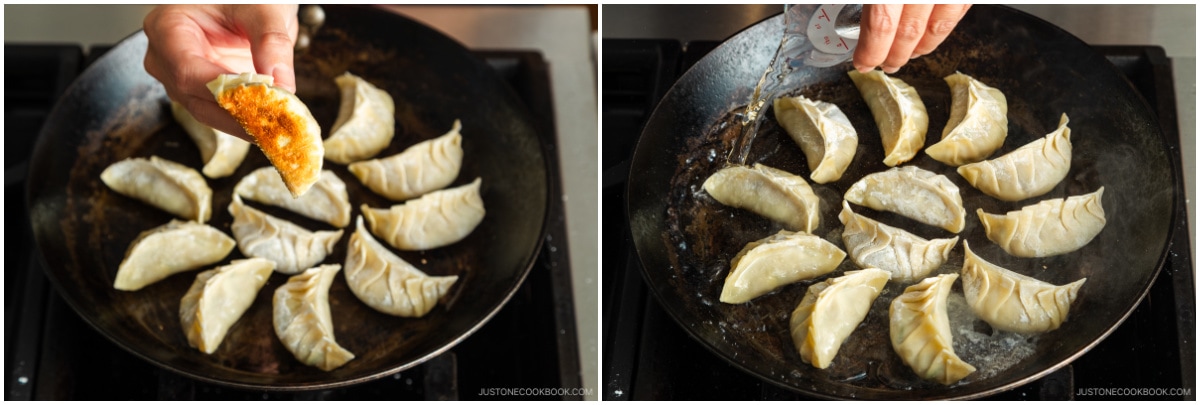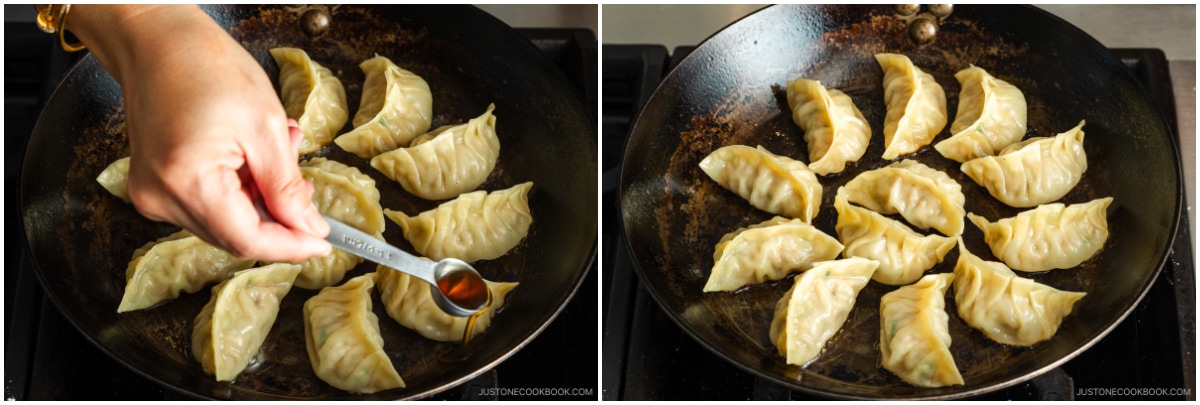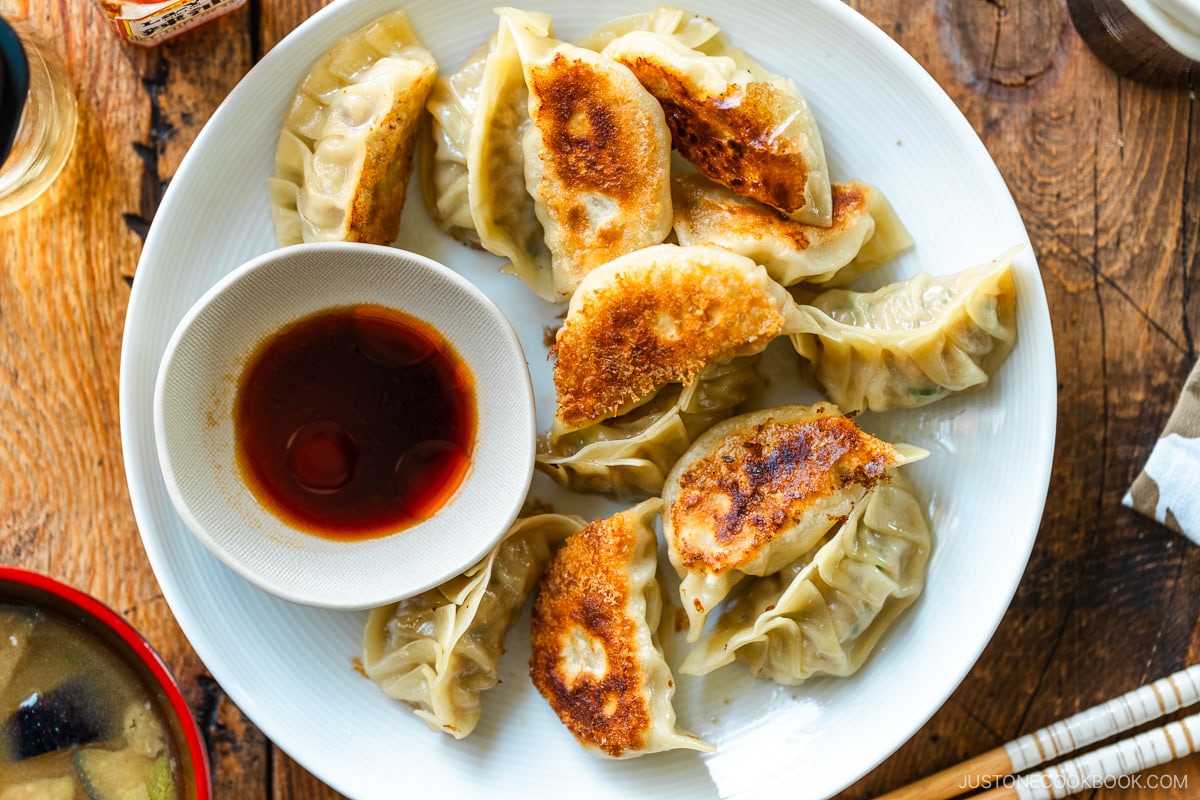Gyoza (Japanese Potstickers) (Video) 餃子
Gyoza are the famous Japanese pan-fried dumplings that are crisp and golden on the bottom and juicy inside. With my step-by-step photos and video, you’ll soon be folding and making your own gyoza at home! Dipped in a savory sauce, they’re a mouthwatering treat.
I’ve been making gyoza (餃子) since middle school, and it’s one of the dinner menu items that my mom and I often prepared together. We stood in the kitchen and folded countless gyoza while talking about life. Looking back, it’s such a comforting memory for me. With the tips I share in today’s Gyoza recipe, you can start making these Japanese pan-fried dumplings at home and create your own delicious and happy memories, too!
What is Gyoza?
Gyoza are the Japanese version of Chinese dumplings called jiaozi (餃子). When World War II ended and Japanese settlers returned from Manchuria, they brought back a taste for northern Chinese cuisine. To make a living, returnees set up food stalls where they sold gyoza—a word derived from the northern Mandarin dialect. This popular dumpling was smaller with a finer filling and thinner wrapper than the Chinese potsticker. These juicy and crispy gyoza quickly caught on in Japanese home cooking as an inexpensive, nutritious, easy-to-make, and undeniably delicious dish.
If you love Japanese pan-fried dumplings, try my Vegetable Gyoza (vegan/vegetarian), Gyoza with Wings (Hanetsuki Gyoza), and Napa Cabbage Gyoza with Miso Dipping Sauce recipes next!
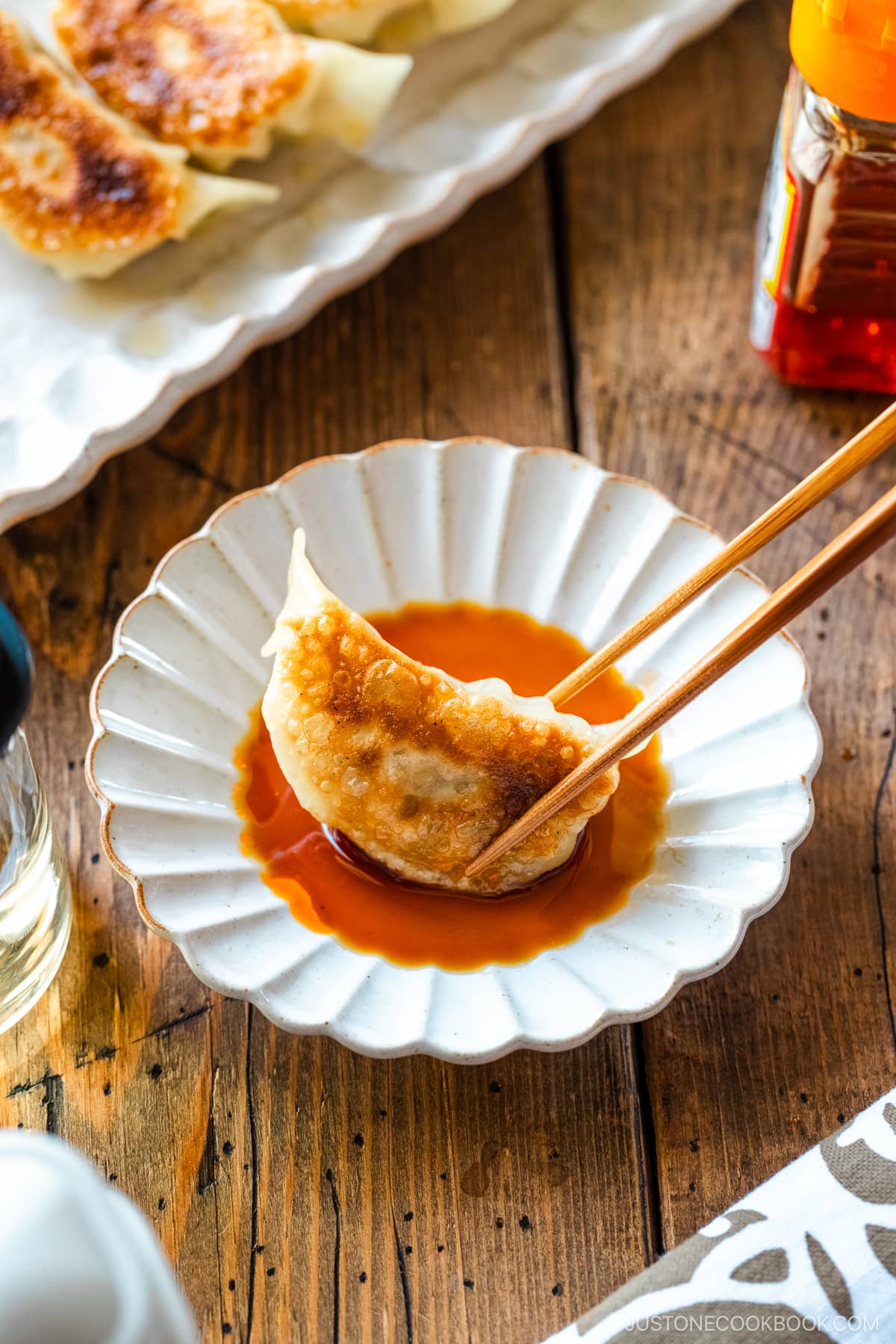
Why I Love This Recipe
You can find these mouthwatering dumplings on the menu practically everywhere in Japan—at specialty shops, izakaya, ramen shops, grocery stores, and festivals. While store-bought is convenient, you can’t beat the taste and texture of homemade gyoza.
- The best combination of textures – They’re juicy and tender inside, yet crispy on the bottom. So delicious!
- Satisfying and nutritious – These tasty little parcels have protein, vegetables, and carbs all in one bite. They’re hard to stop eating, especially when dipped in your favorite sauce!
- Step-by-step folding instructions with photos and video – Folding these dumplings may seem intimidating, but it’s easy to do with a little practice. I guide you with photos at each step of the process. I show you how it’s done in my video, too.
- Fun to make with friends and family – Throw a gyoza-making party! Gyoza taste even better when you involve family or friends in folding them together. Part of the fun of making homemade gyoza is the process.
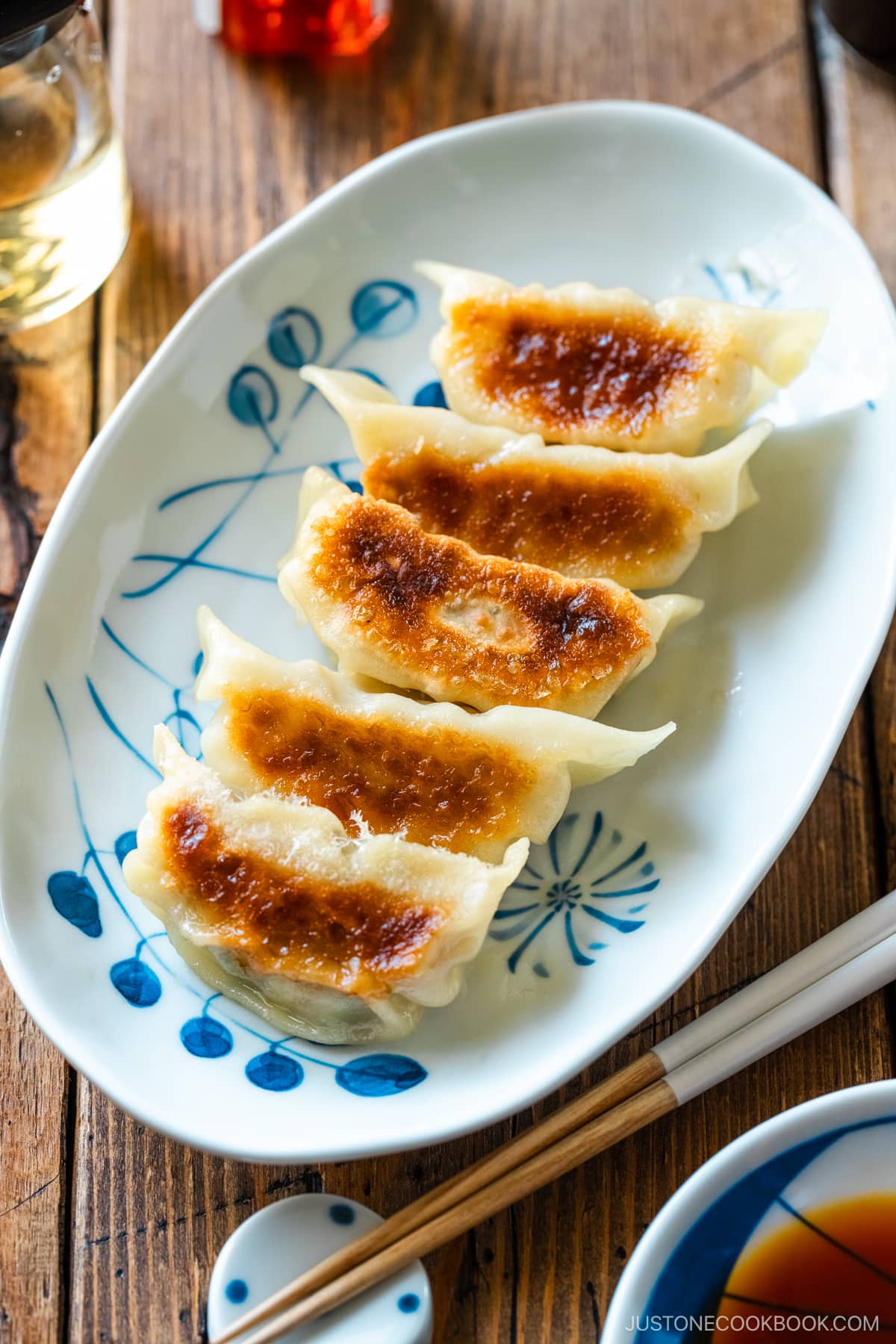
Ingredients for Gyoza
- Gyoza wrappers
- Ground pork
- Green cabbage
- Kosher salt – for wilting the cabbage
- Green onions/scallions
- Fresh shiitake mushrooms
- Garlic
- Ginger
- Sake
- Toasted sesame oil
- Soy sauce
- Freshly ground black pepper
- Neutral oil, water, and toasted sesame oil – for cooking
- Dipping sauce:
- Rice vinegar (unseasoned)
- Soy sauce
- La-yu (Japanese chili oil)
Find the printable recipe with measurements below.
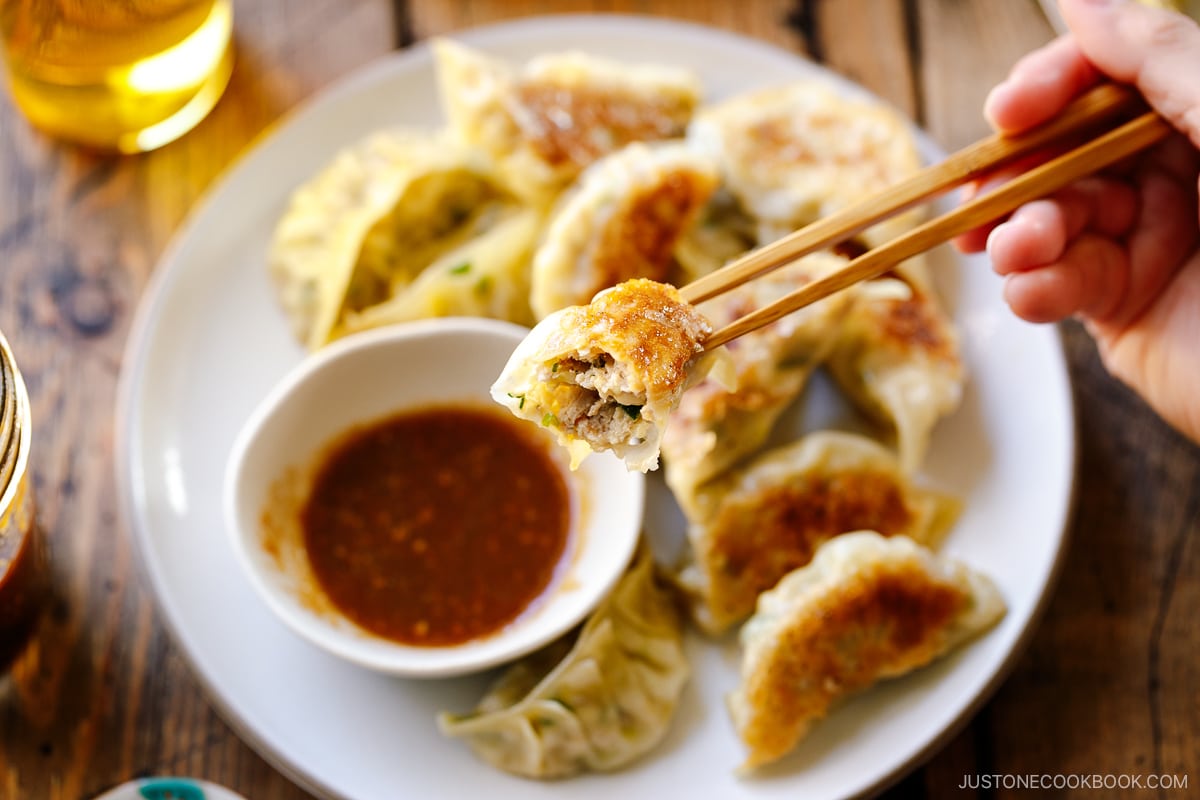
Substitutions
- Green cabbage – We commonly use green cabbage for Japanese gyoza, as opposed to napa cabbage that’s typically used in Chinese potstickers. If you don’t have green cabbage, you can substitute napa cabbage.
- Ground pork – Ground pork is the classic protein for gyoza. If you don’t have it, you can try another protein like ground beef, lamb, turkey, or chicken. You can also substitute with tofu and/or mushrooms for a plant-based option.
- Sake – Besides adding umami, sake helps remove unwanted smells from the meat/seafood. Alcohol evaporation takes away the pork’s gamey smell. If you don’t consume alcohol, simply omit it since the garlic and ginger in this recipe help to remove the unwanted odor.
- Gyoza wrappers – I recommend a Japanese brand like Myojo (my go-to) since the dough is thinner than Chinese wrappers. You can find them in Japanese or Asian grocery stores. If you have time, I highly encourage you to make the wrappers from scratch with flour, salt, and water! You can see my detailed tutorial with video instructions in my post How To Make Homemade Gyoza Wrappers.
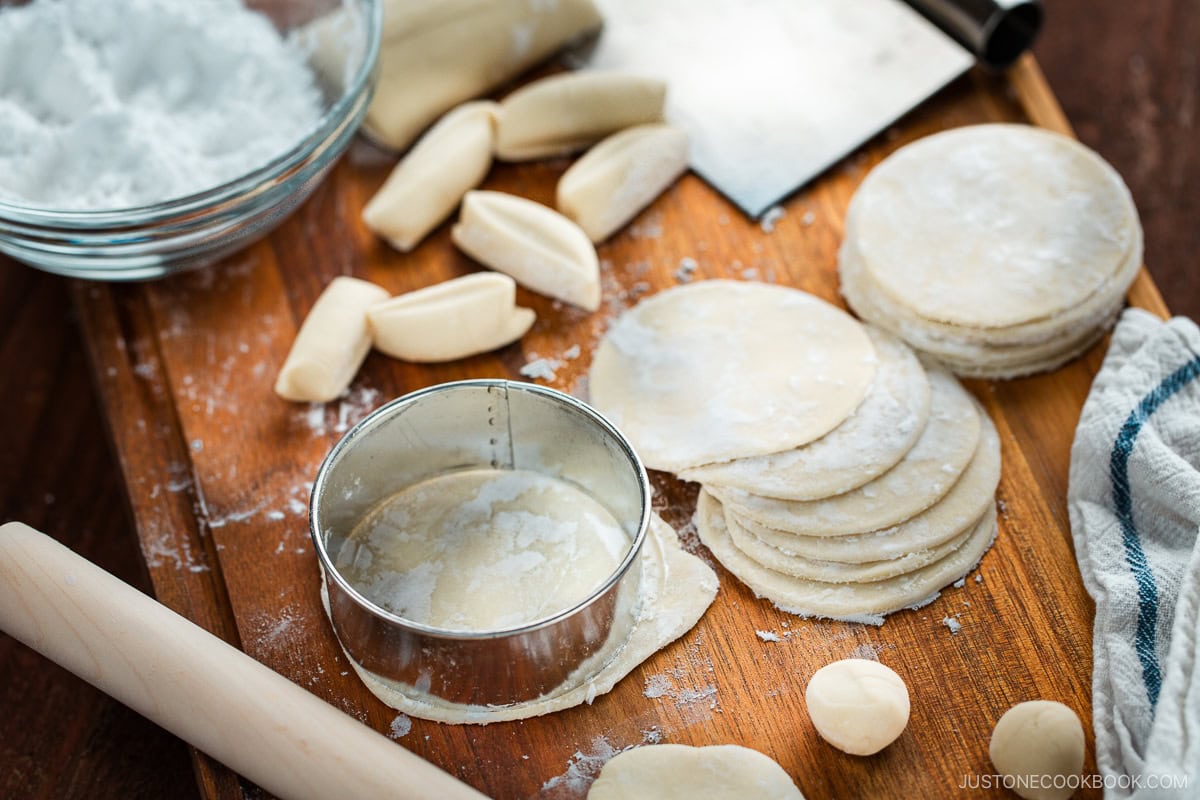
How to Make Gyoza
Preparation
Step 1 – Prep the filling ingredients. Finely chop the cabbage and rub with kosher salt, then set aside to wilt. Mince the other vegetables and mushrooms and add to a large bowl with the ground pork and seasonings.
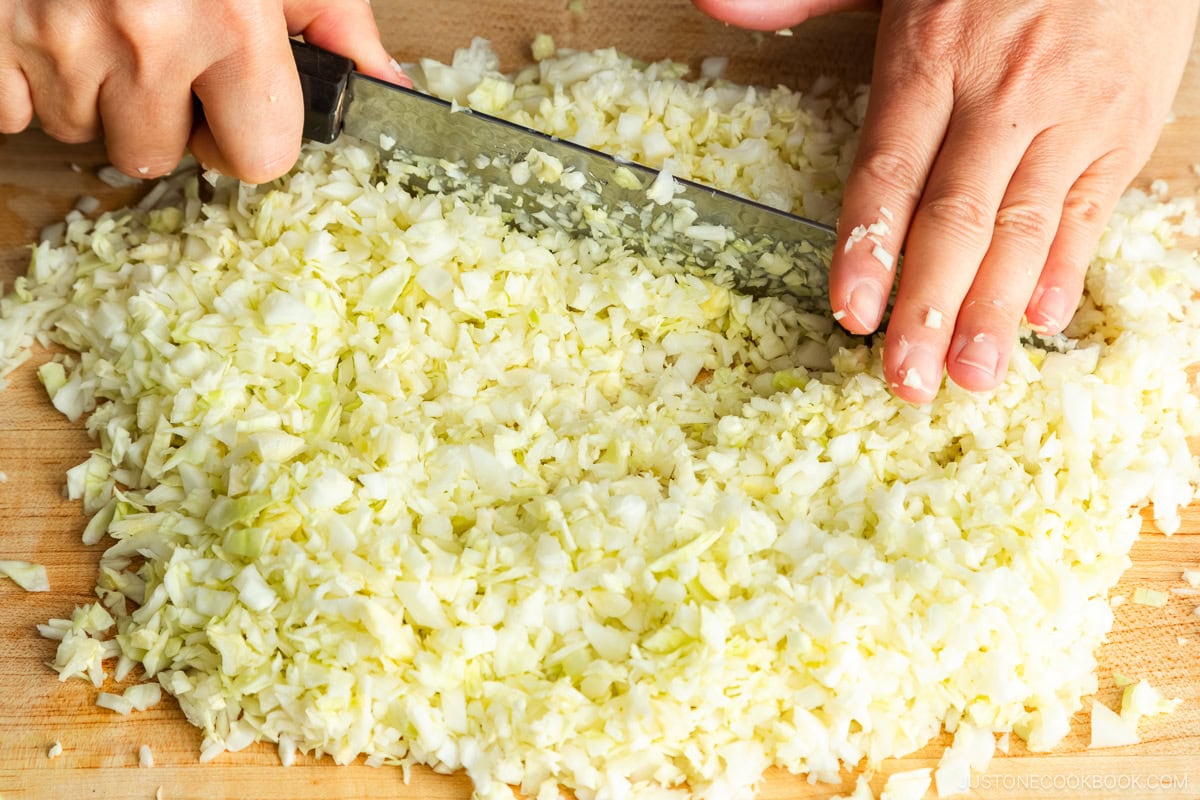
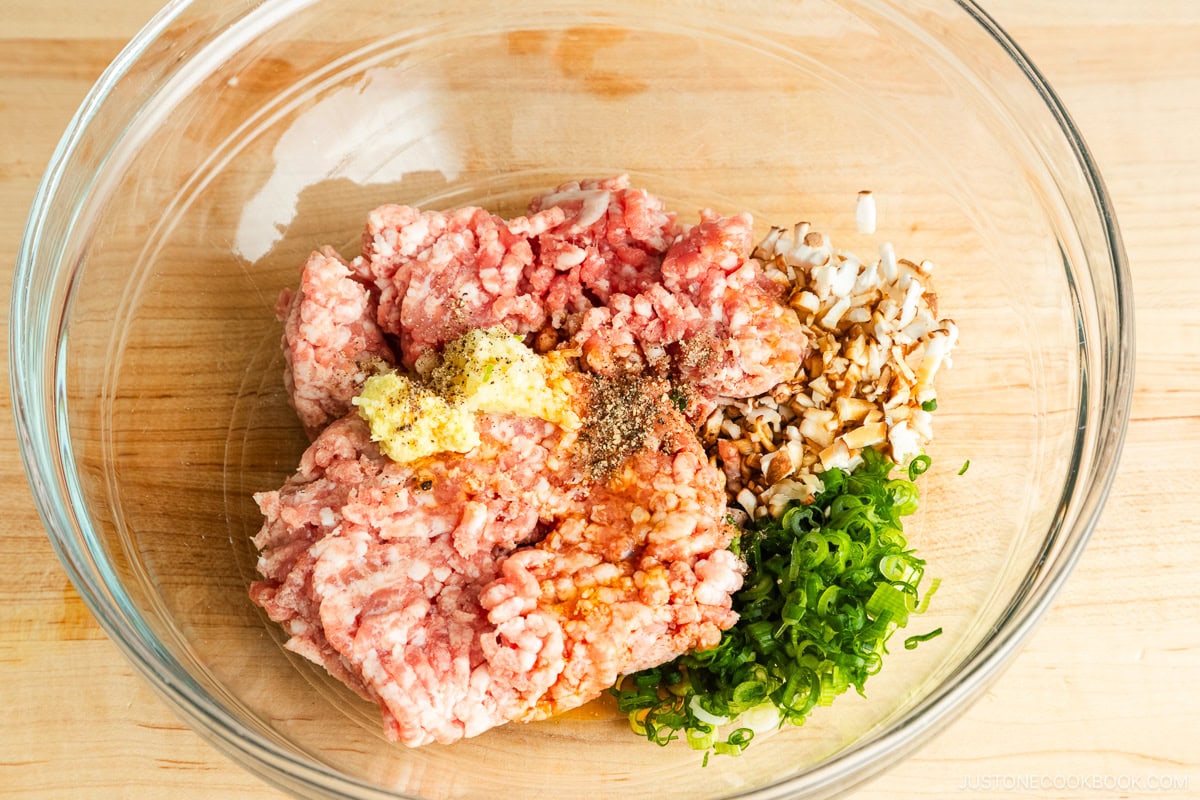
Step 2 – Knead the meat mixture. Mix well and knead the mixture with your hand (I wear plastic disposable gloves) until it becomes sticky and pale in color. Squeeze out the water from the cabbage, then knead it into the meat to distribute evenly.
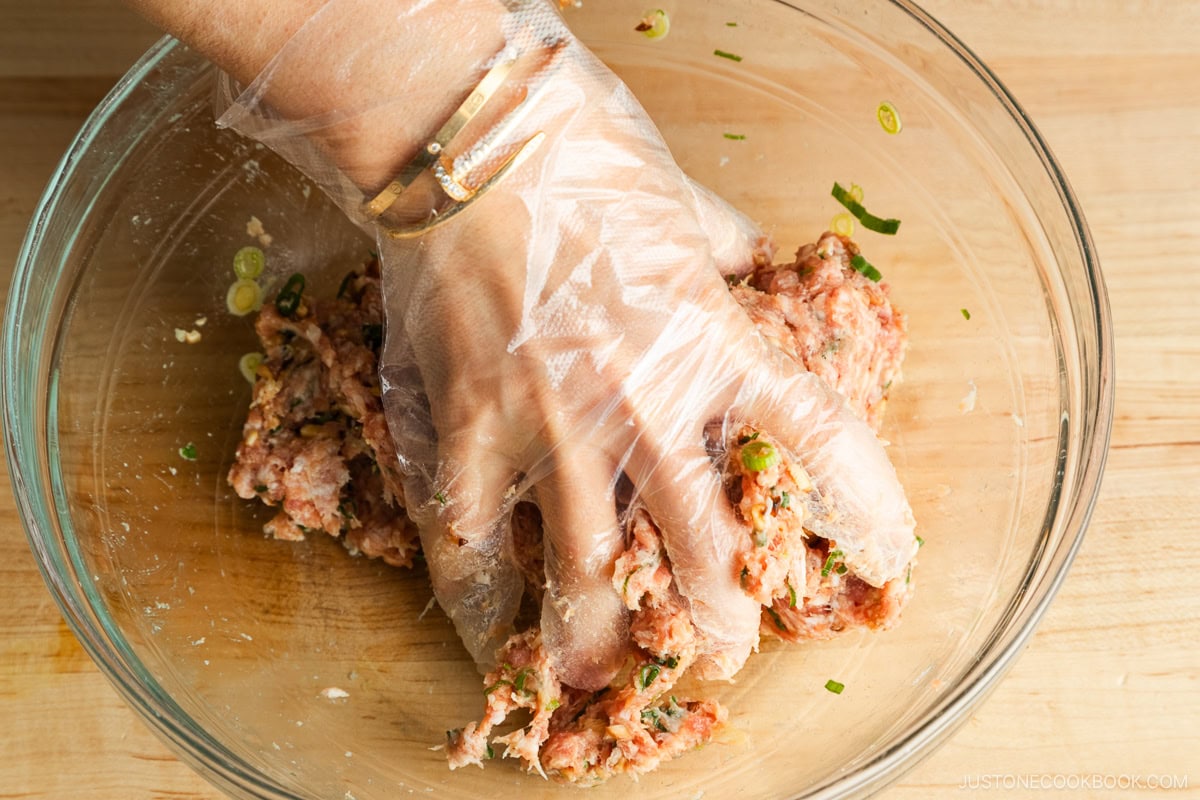
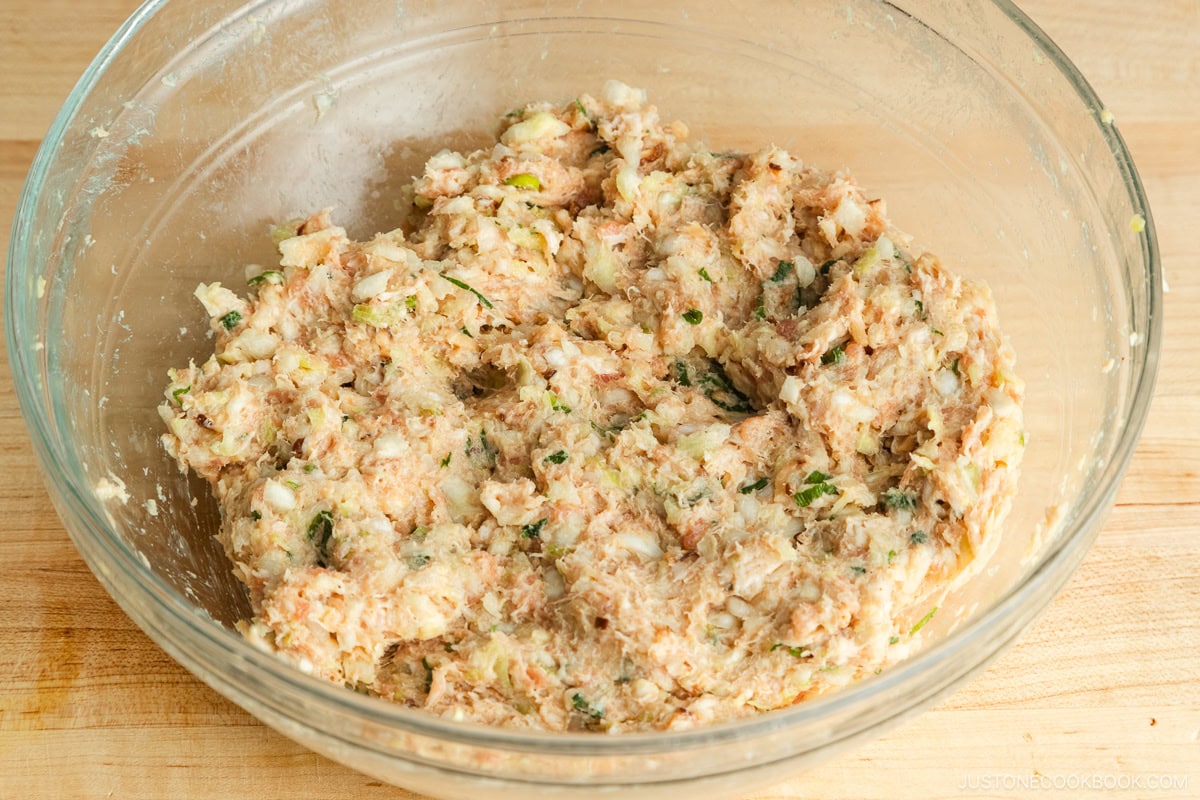
Folding
Step 3 – Add the filling to the wrapper. Hold one wrapper in your non-dominant hand and place small amount of filling in the center. Dip one finger in water and moisten a circle around the wrapper’s edge. Fold in half and pinch together at the top center, but don’t seal.
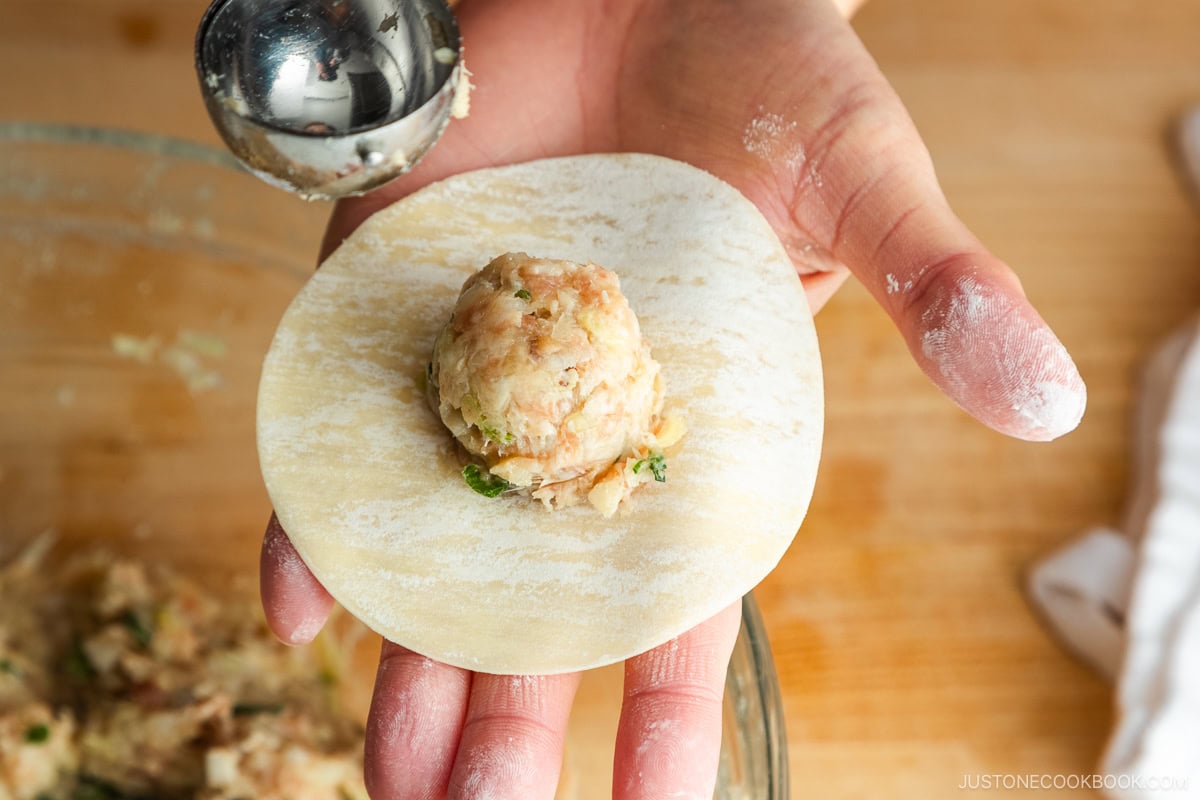
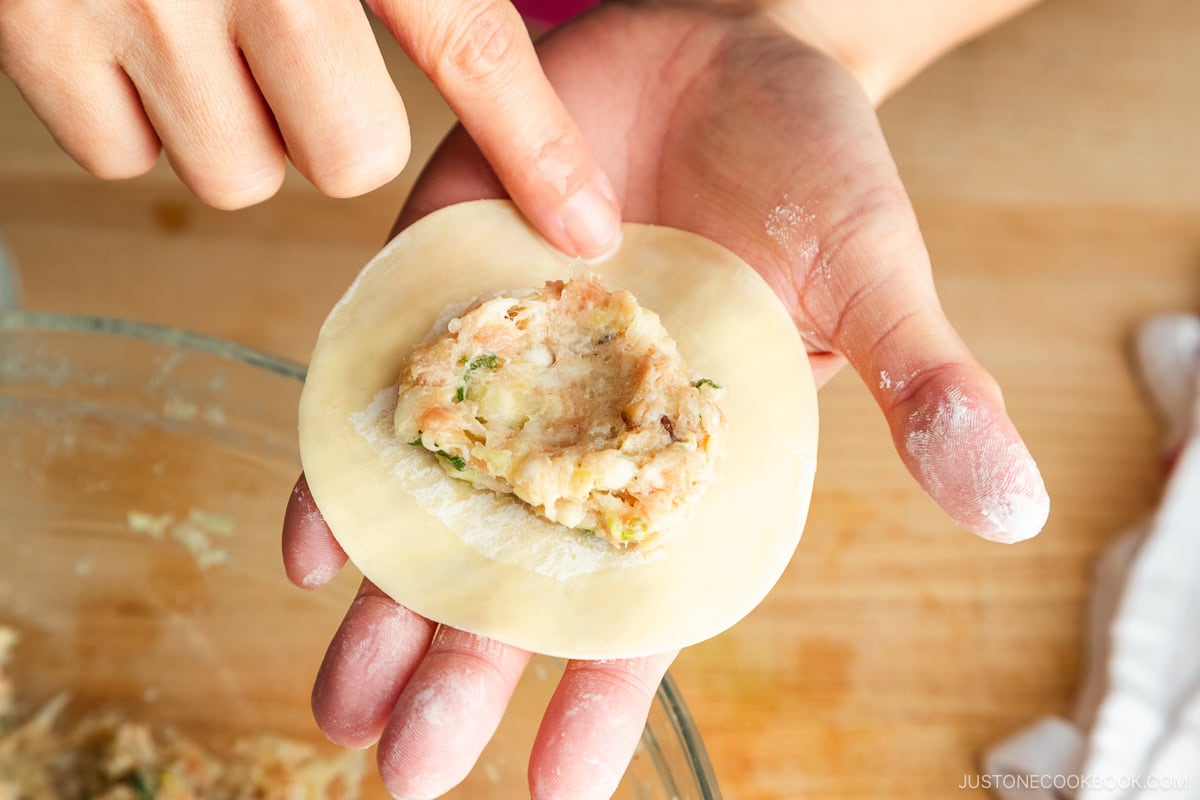
Step 4 – Make pleats leaning toward the center. Starting to the right of top center, fold a pleat that leans toward the top center using your right thumb and index finger. Press it firmly against the back half of the wrapper with your left thumb and index finger. Repeat to make 3–4 pleats total on that side; repeat in reverse on the left side.
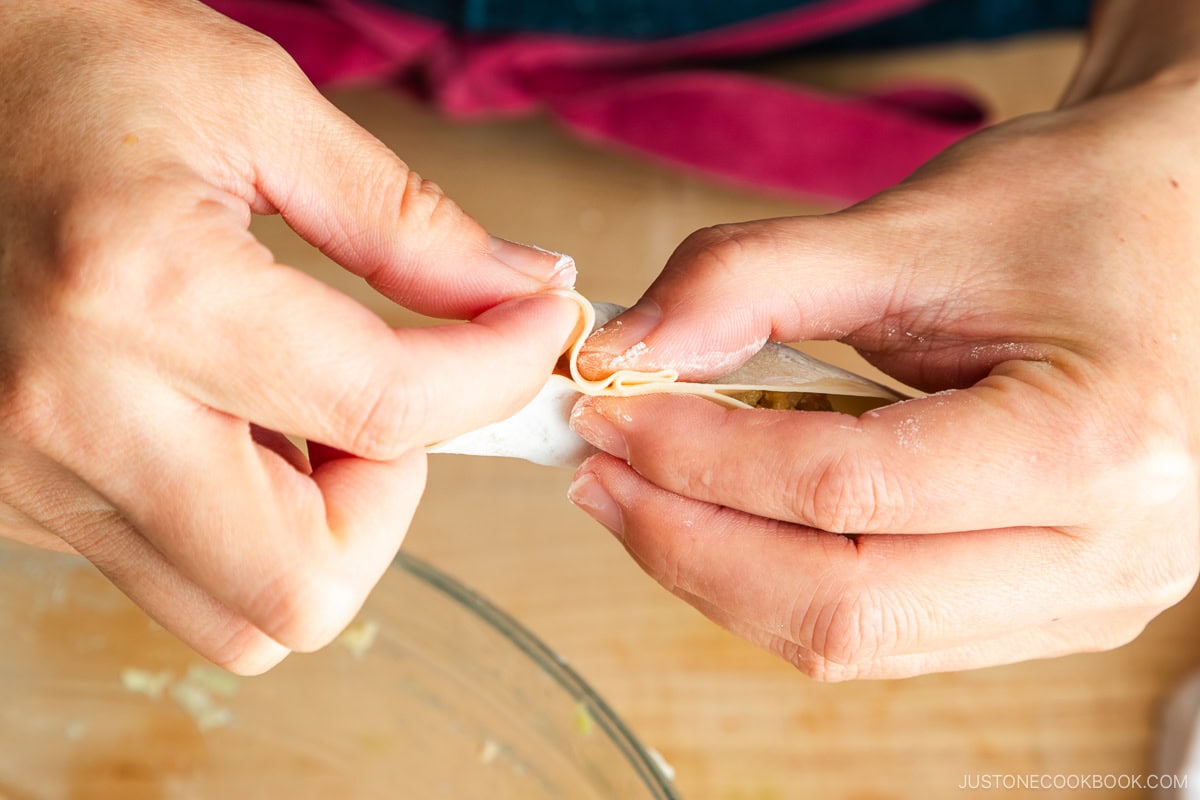
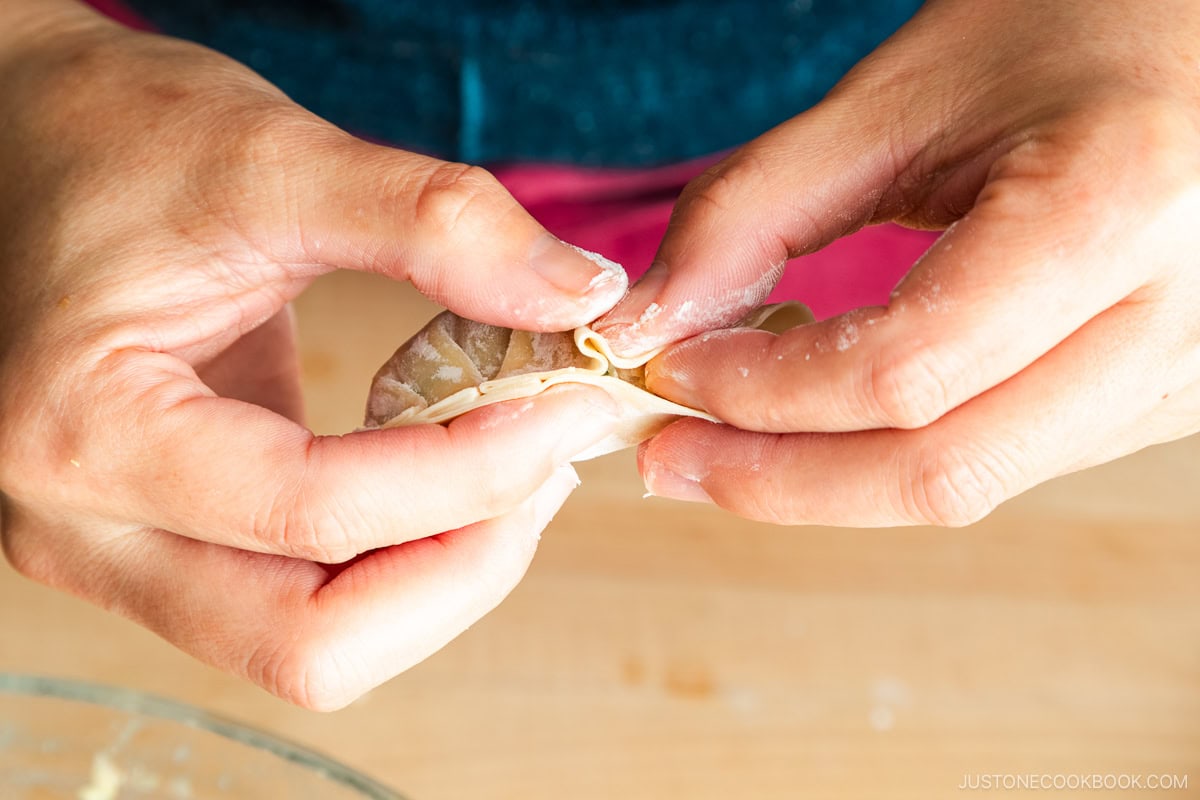
Step 5 – Shape the dumpling. Evenly distribute the filling and shape the gyoza to create a flat side on the bottom.
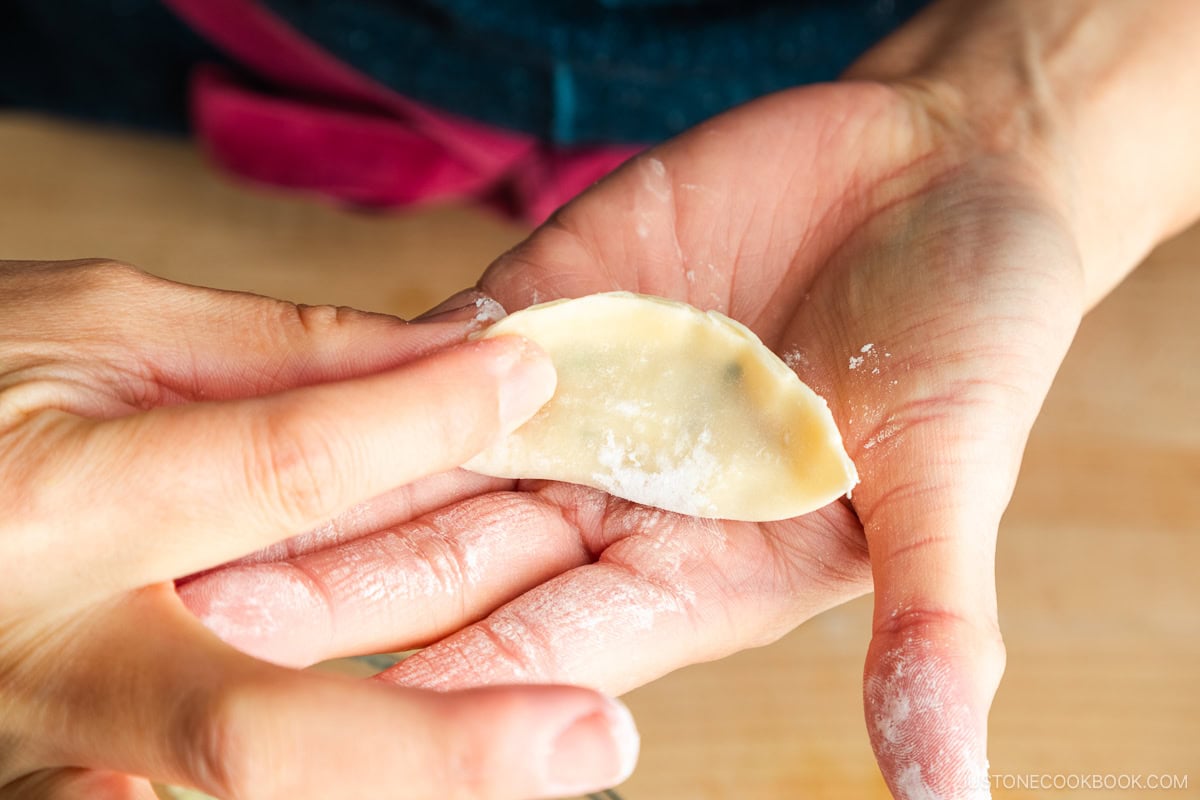
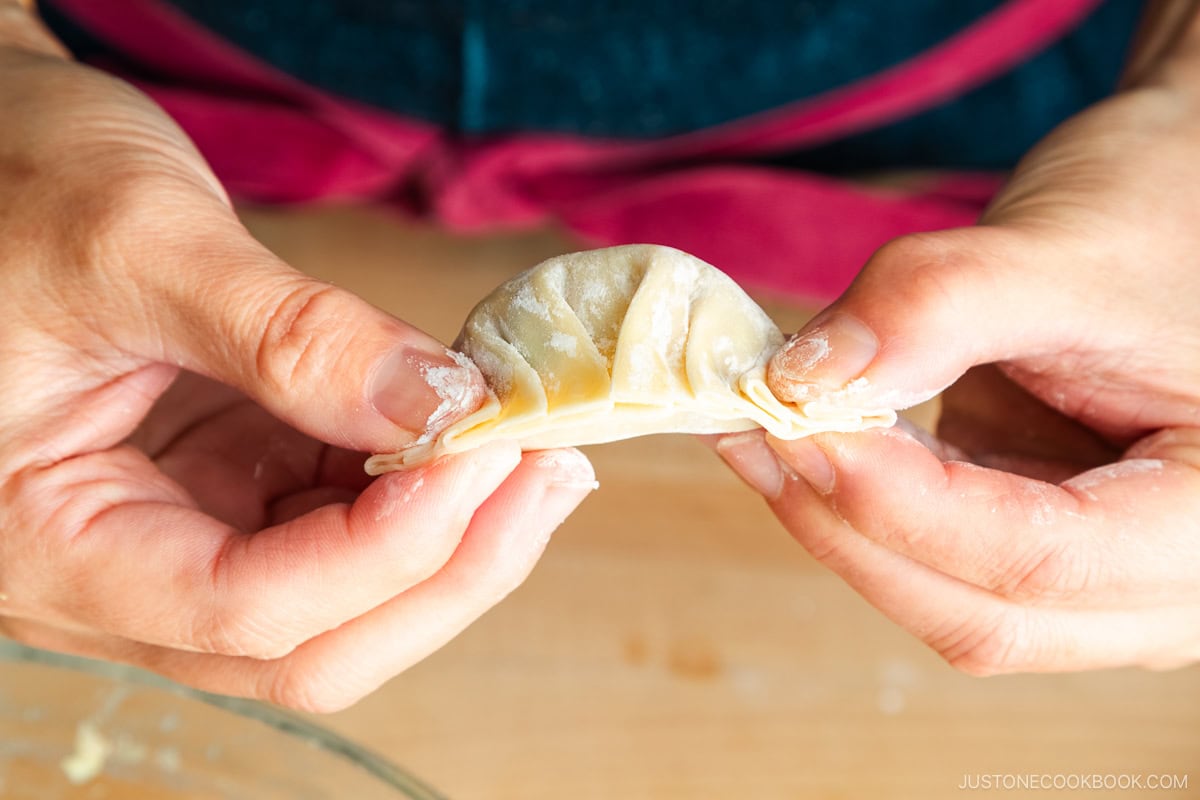
Cooking
Step 6 – Pan-fry in a nonstick skillet or carbon steel pan. To a hot pan over medium heat, arrange the gyoza single layer in a circular pattern. Leave space between each piece so they don‘t touch. Cook until the bottom of the gyoza turns golden brown, about 3 minutes.
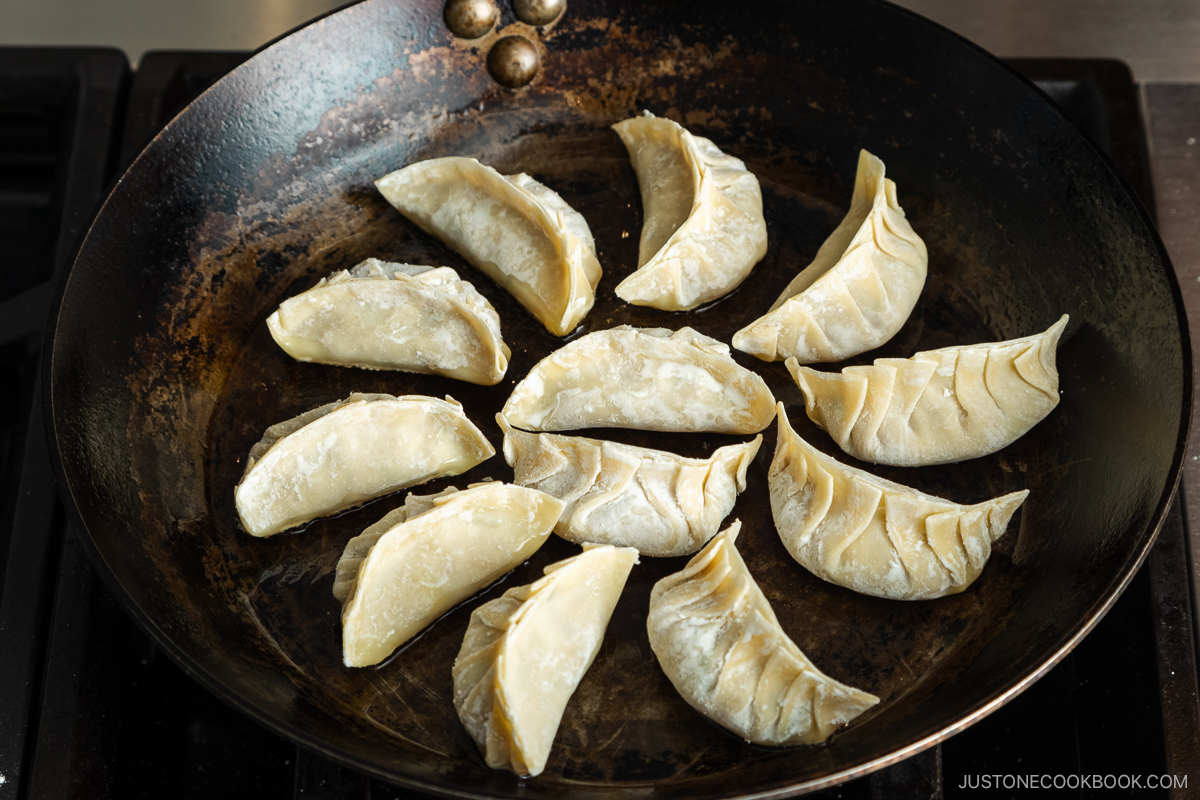
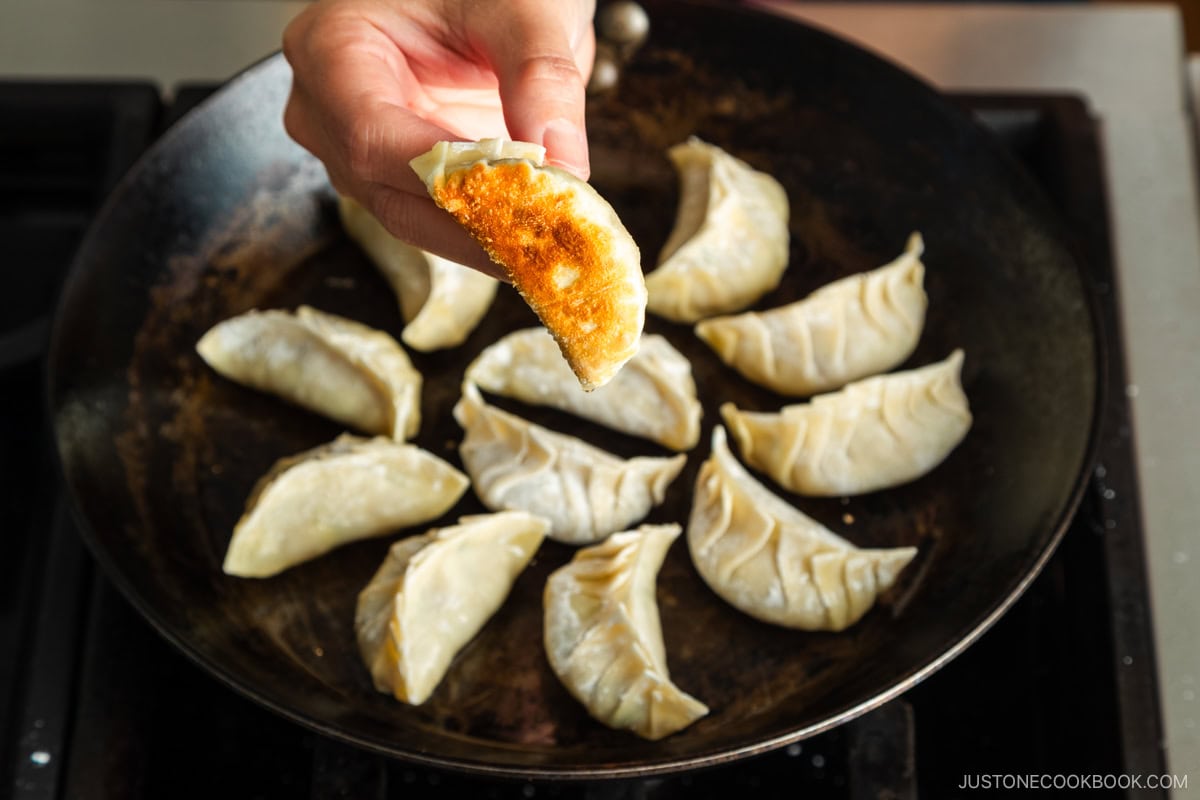
Step 7 – Steam to cook through. Add water to the pan and cover with a lid to steam until most of the water evaporates.
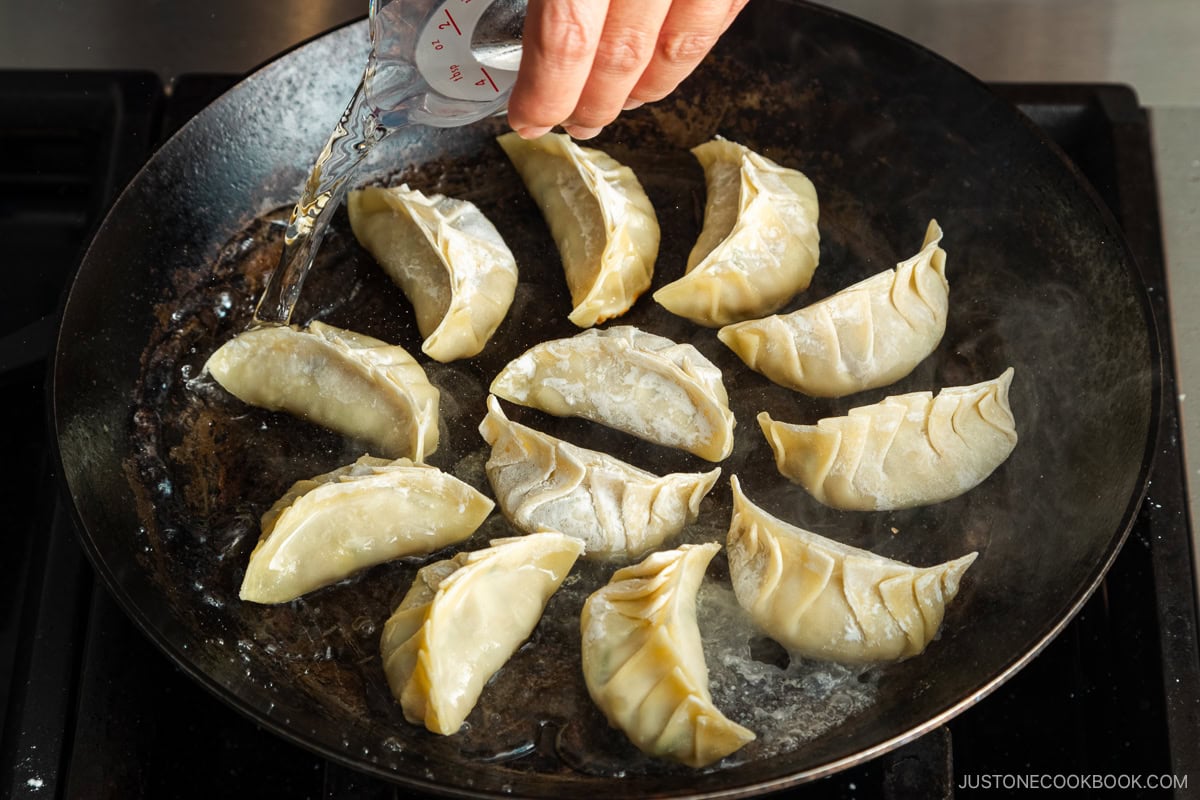
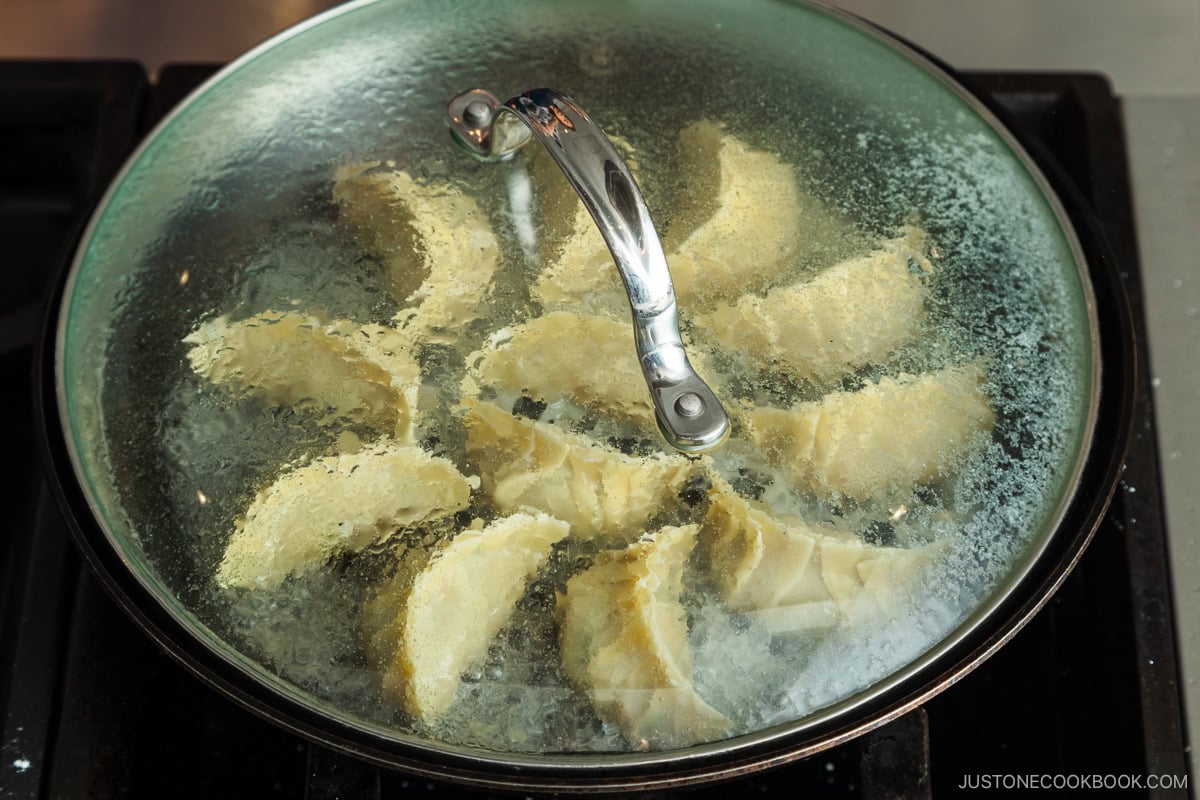
Step 7 – Let the moisture evaporate. Remove the lid to evaporate the rest. Drizzle toasted sesame oil around the gyoza and cook until browned and crisp on the bottom. Serve with dipping sauce and enjoy!
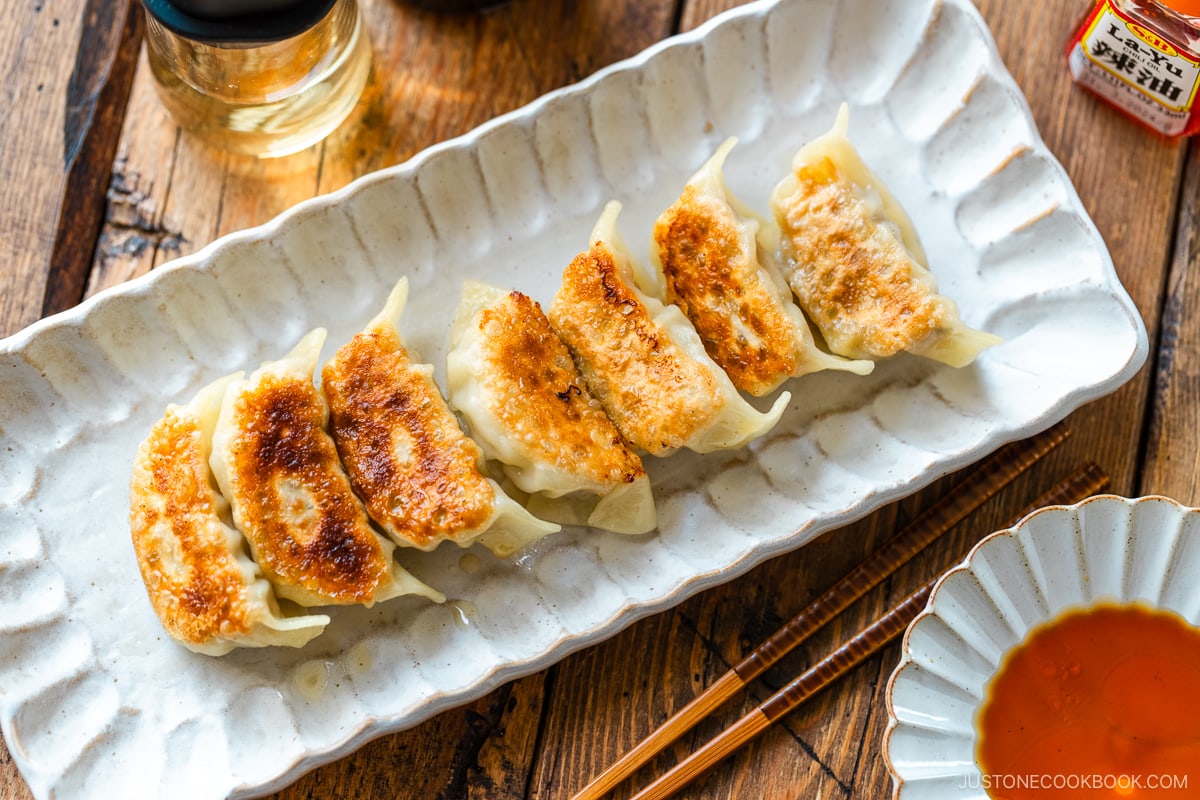
Nami’s Recipe Tips
- Keep the meat-to-cabbage ratio between 1:1 and 1:1.5. In my opinion, this is the best ratio for the perfect juiciness and tenderness. In case you’re curious, the typical gyoza in Japan is 1:2—yes, way more cabbage! I encourage you to adjust the proportions as you like.
- Draw out the moisture from the cabbage. This is very important so that the gyoza wrappers don’t get soggy. After sprinkling salt on the cabbage, squeeze the water out. You’ll be surprised how much water comes out!
- Knead the meat mixture until it’s sticky and pale. Kneading helps the meat proteins bind together for a springier and smoother texture. It also allows the seasonings to blend well with the meat. Instead of using a spatula or spoon, I recommend kneading it with your hand (I wear plastic, food-grade disposable gloves).
- Use less than 1 tablespoon of filling per gyoza. If you add too much filling, it will squeeze out easily. To portion the perfect amount, I use a 1 Tbsp cookie scoop and level off the filling. If you’re a beginner, start with a scant 3/4 Tbsp.
- Cover your gyoza wrappers with a damp towel or cloth. Once you open the gyoza wrapper package, the edges of the gyoza skins dry out quickly. Covering the stack with a damp kitchen cloth or paper towel helps keep them moist and easier to use during the folding process.
- Cook or freeze the folded dumplings right away. Even though you draw out moisture from the cabbage, the filling still contains some moisture. So, don’t let gyoza sit on the counter for too long. Either pan-fry them right away or flash-freeze them (more on that later).
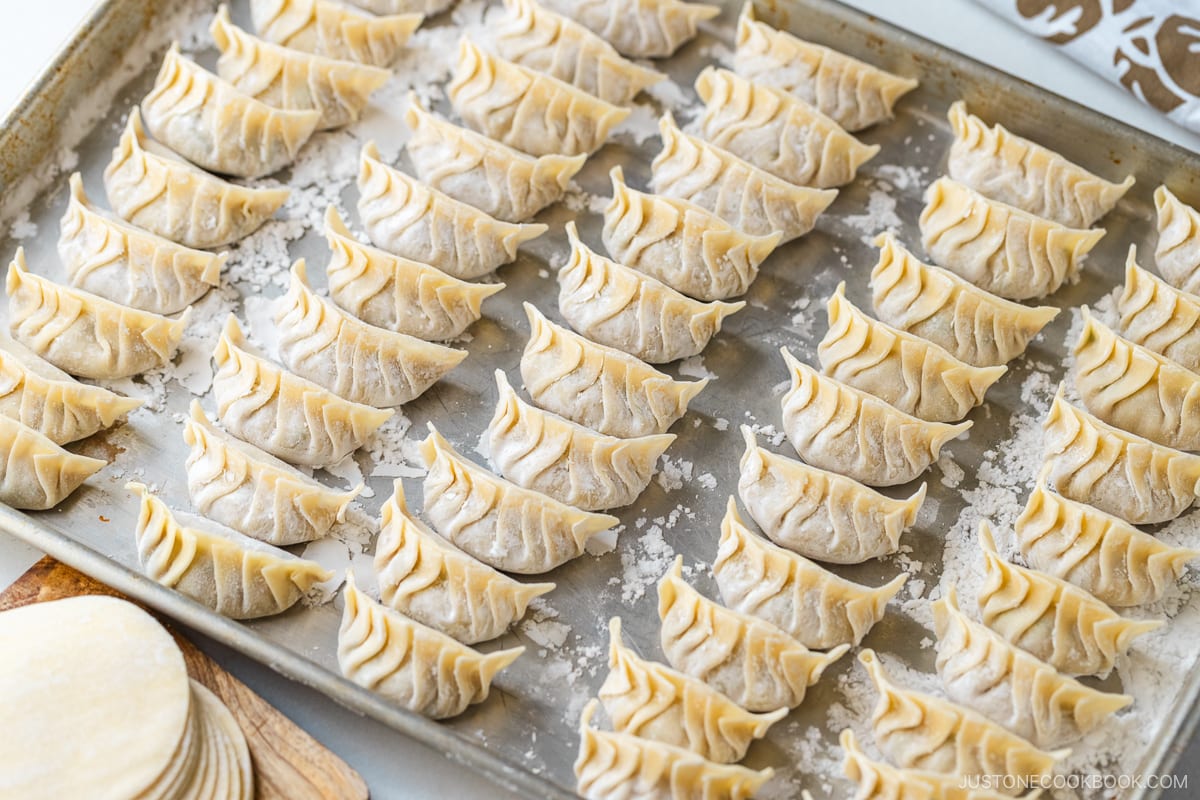
Variations and Customizations
Gyoza is an adaptable food that you can modify to your own preferences! Here are a few of my suggestions.
- Adjust the proportion of cabbage and vegetables. My favorite proportion is 1 to 1.5 parts cabbage for every 1 part of ground pork. However, a typical gyoza in Japan uses 2 parts cabbage to 1 part ground pork. I encourage you to experiment with your
- Add garlic chives. My mom adds garlic chives (nira) to her delicious gyoza, but I skipped them when my kids were little because they didn’t like the strong taste. I add garlic chives to my recipe for Gyoza with Miso Dipping Sauce.
- Get creative with the filling. The rule of thumb for a delicious filling is to use ingredients with different textures. That said, there is plenty of room for creativity. I like to make different versions at home to change things up. For example, this gyoza recipe includes fresh shiitake mushrooms, which is my specialty! I like the meaty texture and juicy umami from shiitake mushrooms without adding more meat.
- Make it vegan/vegetarian. As I show in my Vegetable Gyoza recipe, you can substitute the meat with tofu, mushrooms, and colorful vegetables. I love that I feel light and healthy after eating them!
- Change up the dipping sauce. Modify your dipping sauce to enjoy a different flavor profile. Miso dipping sauce is one of my favorites. Just stir miso, soy sauce, rice vinegar, sugar, and la-yu (Japanese chili oil) until dissolved. I also love ponzu mixed with yuzu kosho as a refreshing dipping sauce like in my Chicken Shiso Gyoza recipe.
- Fold the wrappers with the pleats to one side. Here, I teach you to wrap gyoza with the pleats leaning toward the center. This is one of the two folding methods for Japanese pan-fried dumplings. If you want the pleats to lean toward one side, check out my How to Fold Gyoza post.
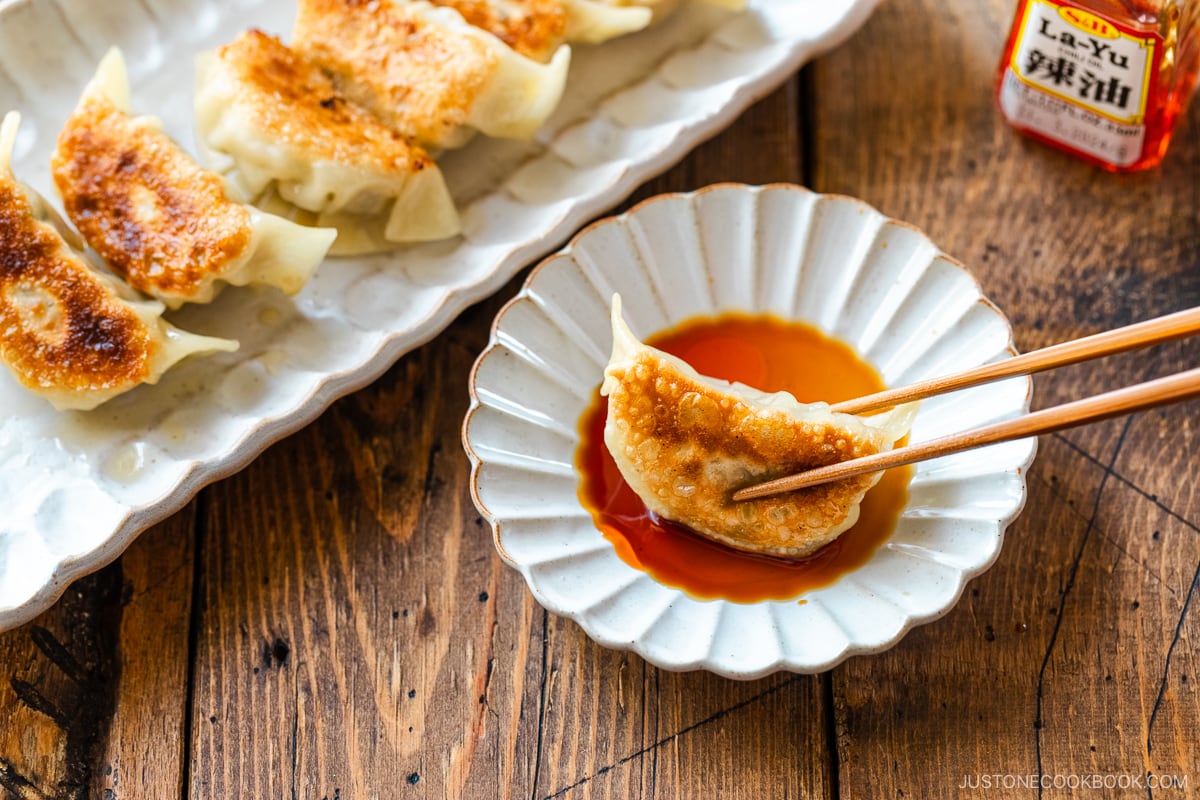
What to Serve with Gyoza
Gyoza is beloved throughout Japan as an appetizer, main dish, after-school snack, or gastropub food. I recommend serving this versatile dish in these other popular ways.
- Alongside ramen – Ramen shops often serve gyoza in a set meal with Miso Ramen and other ramen noodle soups.
- In a hot pot – Dumplings are a perfect addition to Japanese hot pots, like this Korean-inspired Kimchi Gyoza Nabe.
- With other appetizers – You’ll often find gyoza offered alongside Karaage (Japanese fried chicken).
- In bento – Last night’s gyoza leftovers make a delicious boxed lunch in Gyoza Bento.
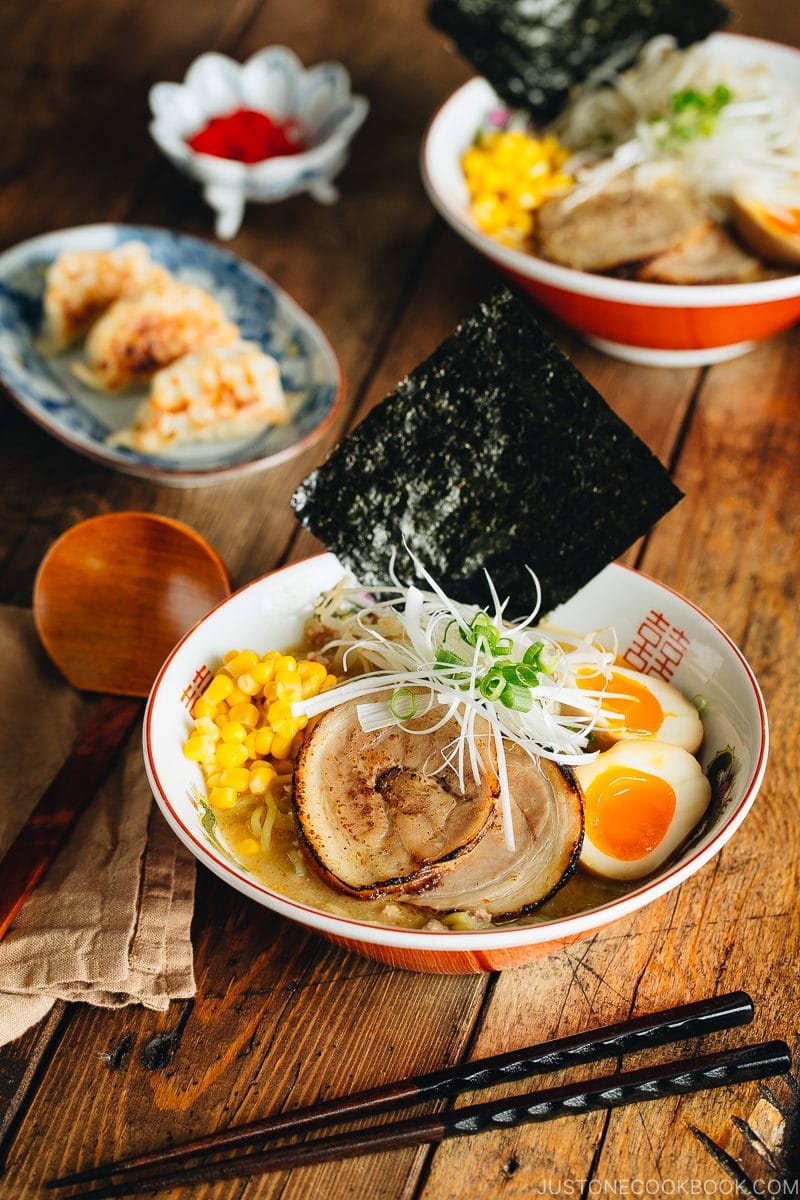
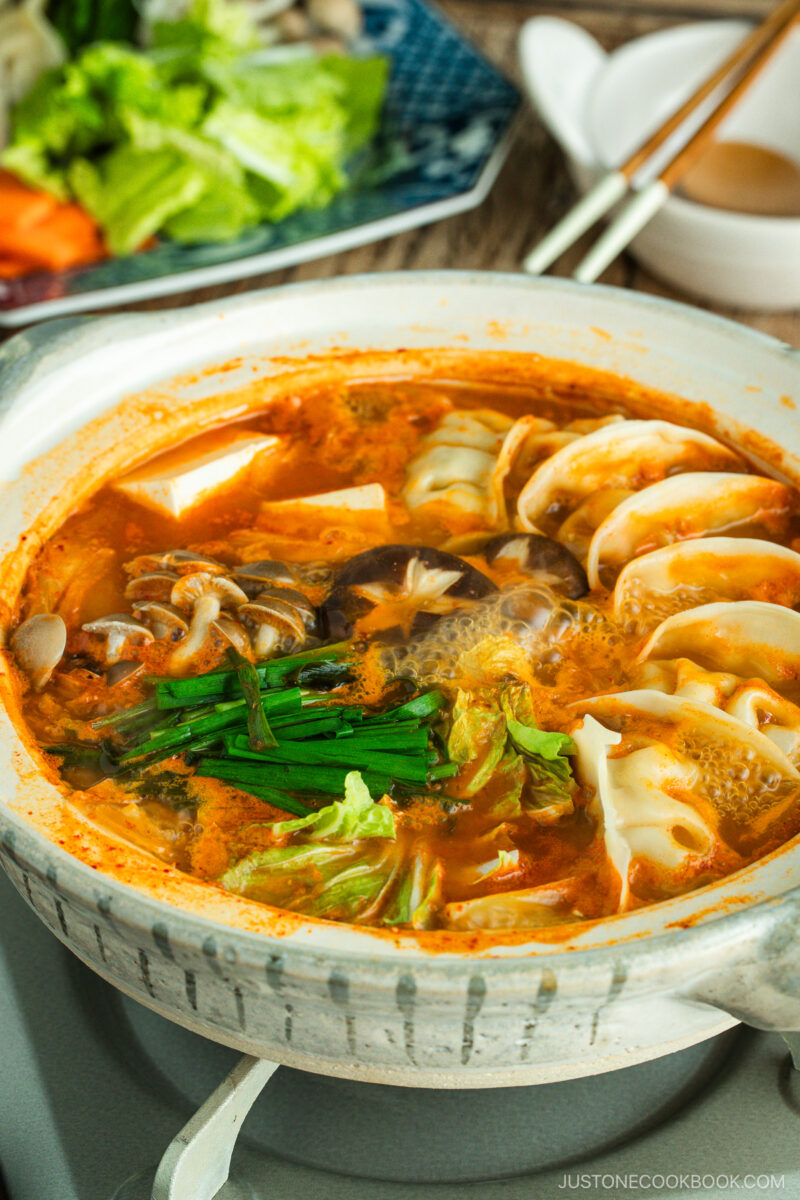
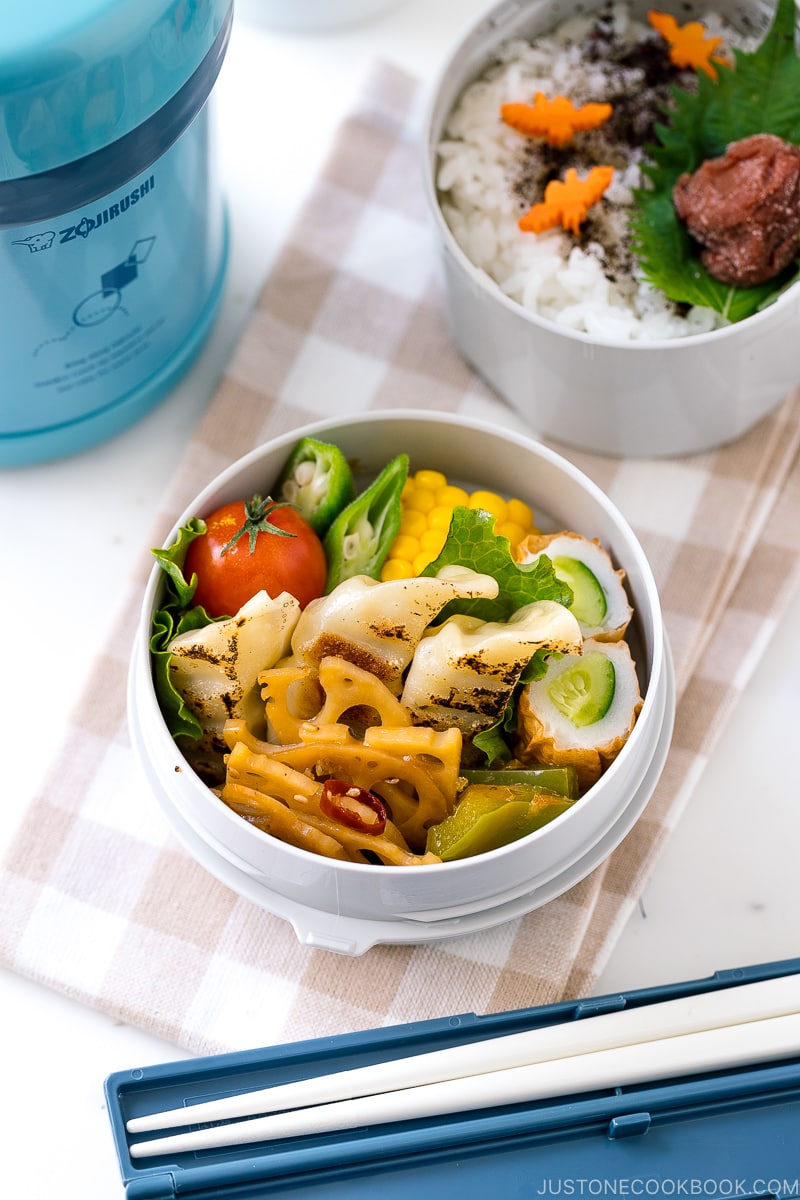
Storage Tips
To store uncooked gyoza: It’s best to store freshly folded gyoza frozen, before they are cooked. Before the filling starts to release moisture and make the wrappers soggy, lay out the gyoza on a baking sheet pan or plate in a single layer so they‘re not touching. Then, cover with plastic wrap and place in the freezer to flash freeze. Transfer to a resealable freezer bag and store for up to 1 month in the freezer. When you’re ready to cook them, place the frozen gyoza directly in your frying pan. Follow the regular cooking instructions, but steam them for an extra 1–2 minutes.
To store leftovers: Cooked gyoza: Cool, transfer to an airtight container, and store in the fridge for up to 3 days or in the freezer for a month. Filling: Make mini meatballs or patties, cook them in a frying pan, cool and pack in an airtight container, and refrigerate or freeze. Wrappers: I love making crispy cheese wraps with the extra gyoza skins. Fill each wrapper with sliced cheese, fold in half, and press to seal. Pan-fry until golden on both sides.
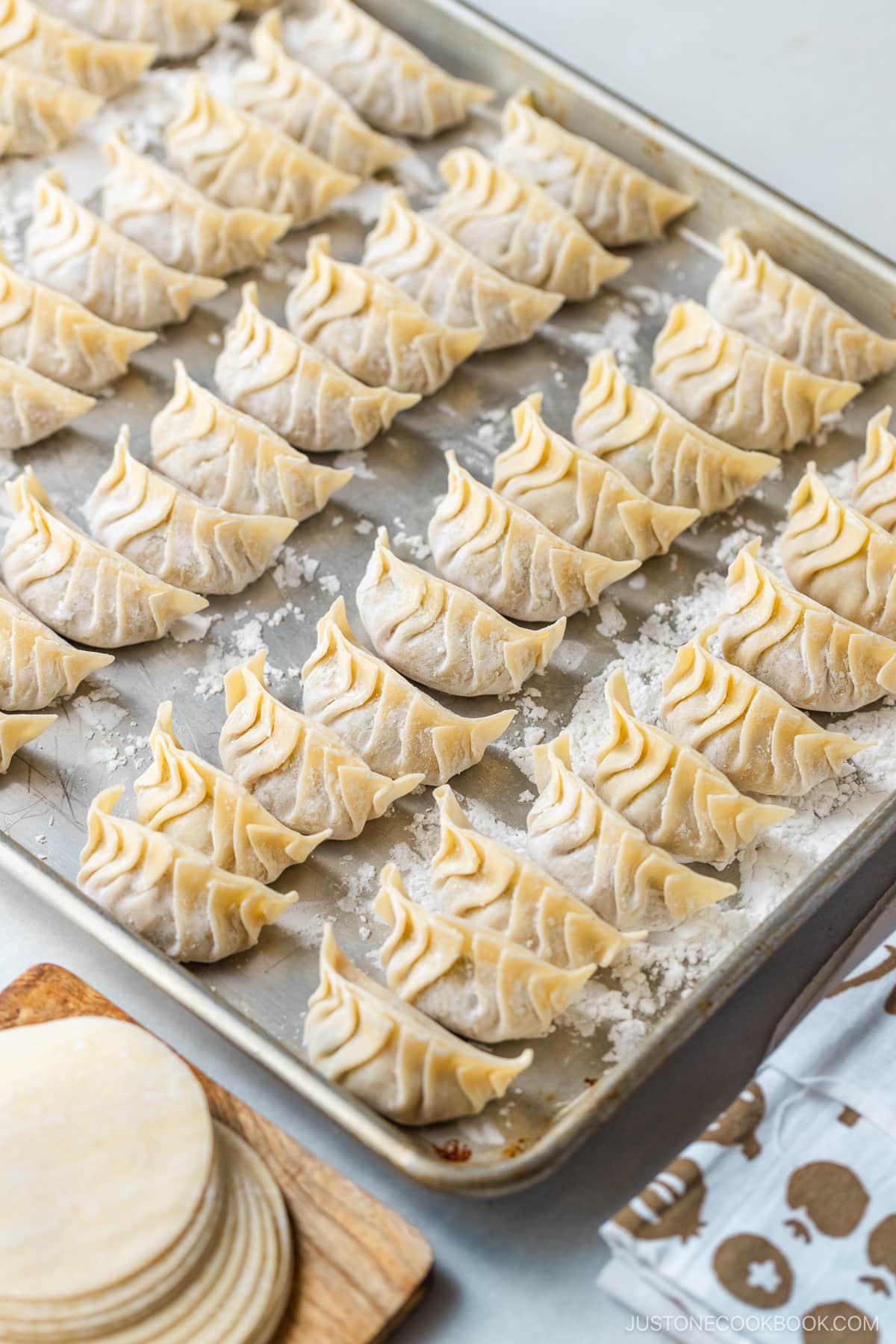
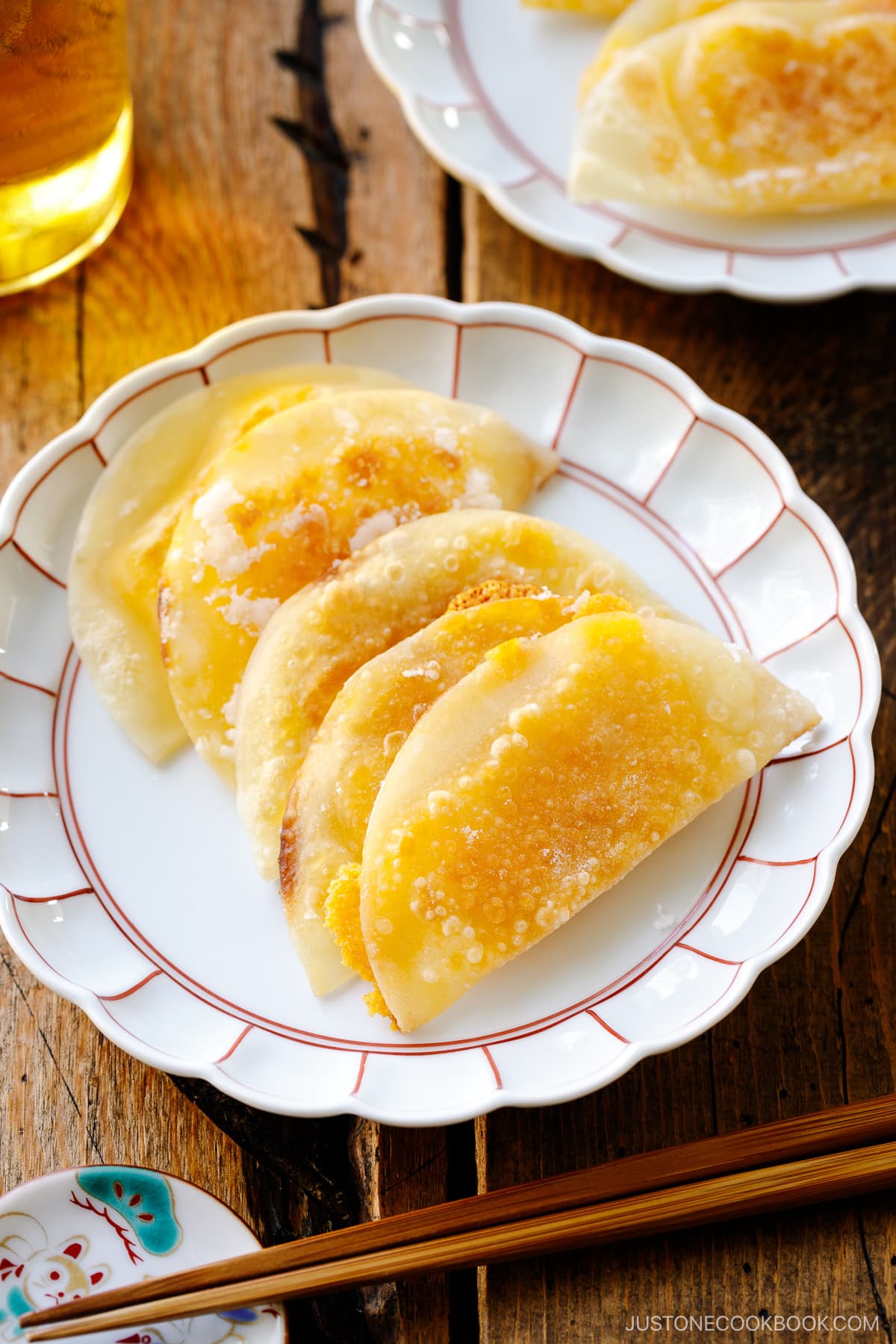
Frequently Asked Questions
Can I make gyoza ahead of time?
Yes! I prep and freeze gyoza all the time for quick, homemade meals on busy nights. To save time, you can make the filling and fold the gyoza, then freeze them in advance. When you want to serve, simply pan-fry according to the directions, but steam them an extra 1–2 minutes. I usually double or triple the recipe, and freeze them for later use.
Why did the filling squeeze out while I folded the gyoza?
You may have added too much filling to the wrapper. I recommend using less than 1 Tbsp of filling per gyoza. If you’re a beginner, I suggest starting with 3/4 Tbsp of filling. I use a 1 Tbsp cookie scoop to measure my filling.
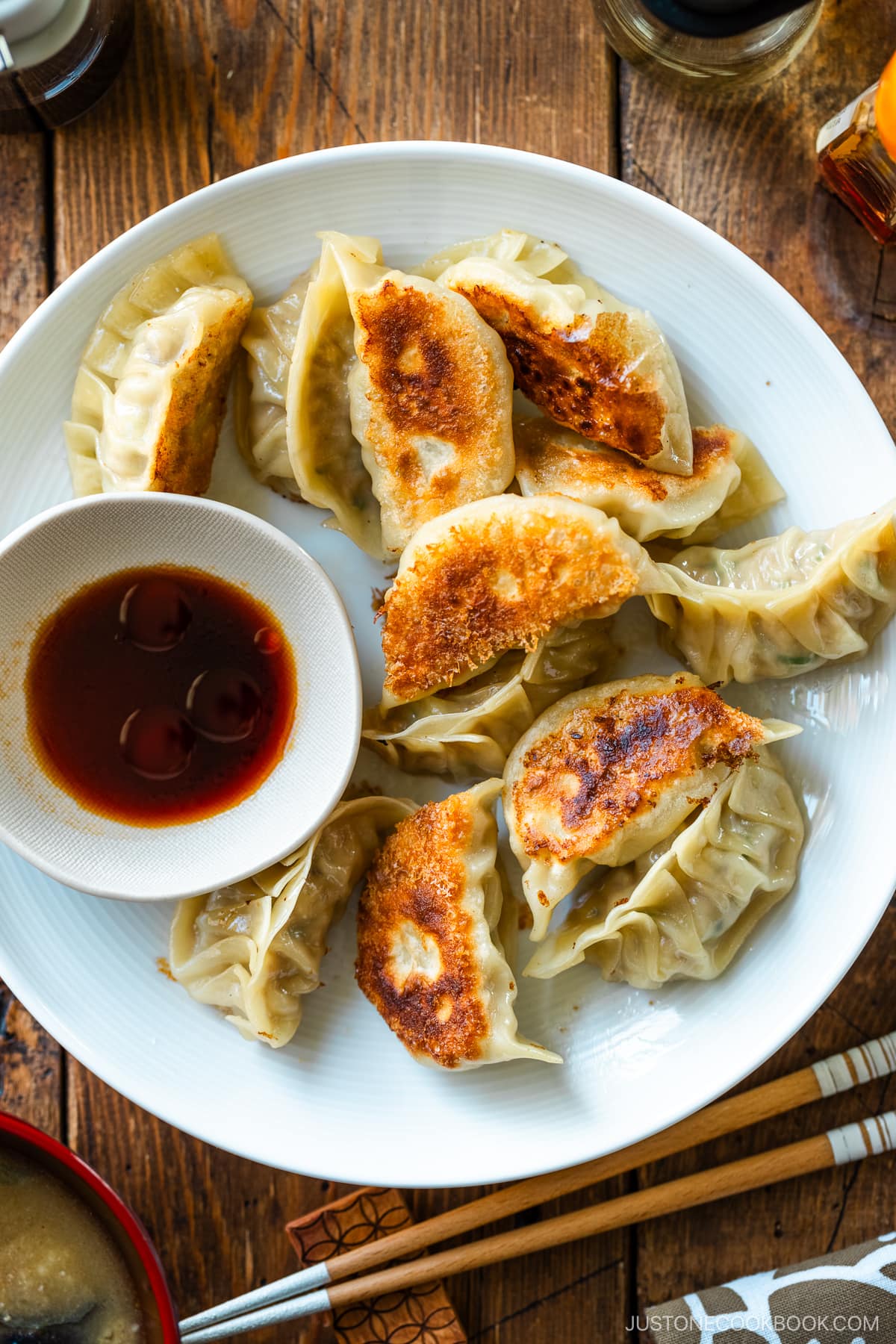
More Dumpling Recipes
If you love this Gyoza, you’re in for a treat with these other irresistible Chinese-style dumpling recipes.
- Wonton Soup
- Pork Shumai (Steamed Pork Dumplings)
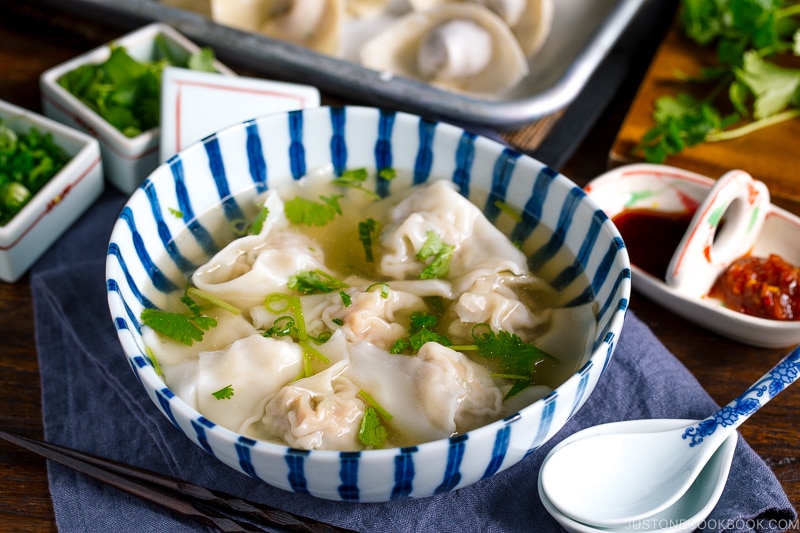
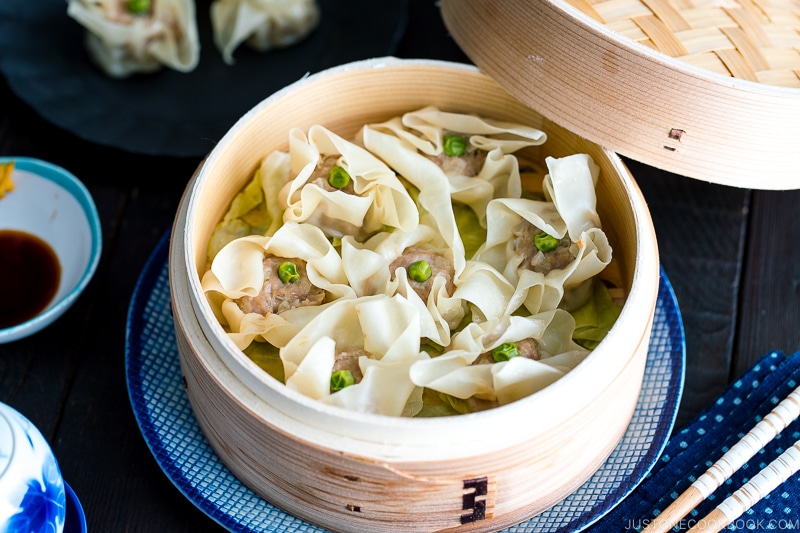
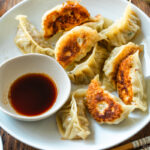
Gyoza (Japanese Potstickers)
from votes Gyoza are Japanese pan-fried dumplings that are crisp and golden on the bottom and juicy inside. These meat-filled treats are easy to fold using one of the methods I show here. They‘re so delicious served with my savory dipping sauce. Print Pin
Video
Prep Time: 1 hour Cook Time: 20 minutes Total Time: 1 hour 20 minutes Servings: 52 Pieces
Ingredients US CustomaryMetric 1x2x3x
For the Filling
- ▢ ¾ lb green cabbage (¼ large head)
- ▢ 1 tsp Diamond Crystal kosher salt (for salting the cabbage)
- ▢ 2 green onions/scallions
- ▢ 2 shiitake mushrooms
- ▢ 2 cloves garlic
- ▢ 1 tsp ginger (grated, with juice; from a 1-inch, 2.5-cm knob)
- ▢ ½ lb ground pork
For the Seasonings
- ▢ 2 tsp sake (to remove the pork‘s gamey taste; optional)
- ▢ 2 tsp toasted sesame oil
- ▢ 2 tsp soy sauce
- ▢ ⅛ tsp freshly ground black pepper
For Folding the Gyoza
- ▢ 1 package gyoza wrappers (52 sheets per 10-oz/284-g package; or make my homemade Gyoza Wrappers)
- ▢ water (to fold and seal the wrappers)
For Frying Each Batch
- ▢ 1 Tbsp neutral oil
- ▢ 4 Tbsp water
- ▢ 1 tsp toasted sesame oil
For the Dipping Sauce
- ▢ rice vinegar (unseasoned) (1 Tbsp per serving)
- ▢ soy sauce (1 Tbsp per serving)
- ▢ la-yu (Japanese chili oil) (⅛ tsp per serving; optional; Japanese chili oil is not too spicy; or make my Homemade La-yu)
Japanese Ingredient Substitution: If you want substitutes for Japanese condiments and ingredients, click here. Cook ModePrevent your screen from going dark
Instructions
- Gather all the ingredients.
![Gyoza Ingredients]()
To Make the Filling
- Discard the thick core of ¾ lb green cabbage and cut it into thin strips about ⅓-inch (1 cm) wide.
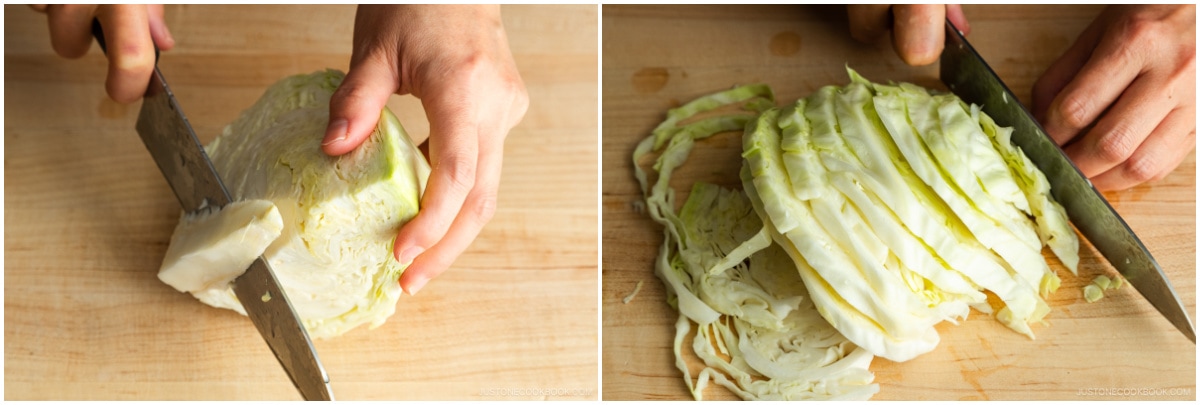
- Finely chop the strips crosswise into very small pieces, especially the thick white parts of the leaves. Then, run your knife through the cabbage to mince it finer.
![Gyoza 2]()
- Sprinkle the minced cabbage with 1 tsp Diamond Crystal kosher salt and massage together with your hands. Transfer it to a bowl and set aside until the cabbage is wilted. Tip: Alternatively, you can blanch or microwave the cabbage for a minute or two to soften the thick and hard leaves. Or, you can skip wilting altogether.
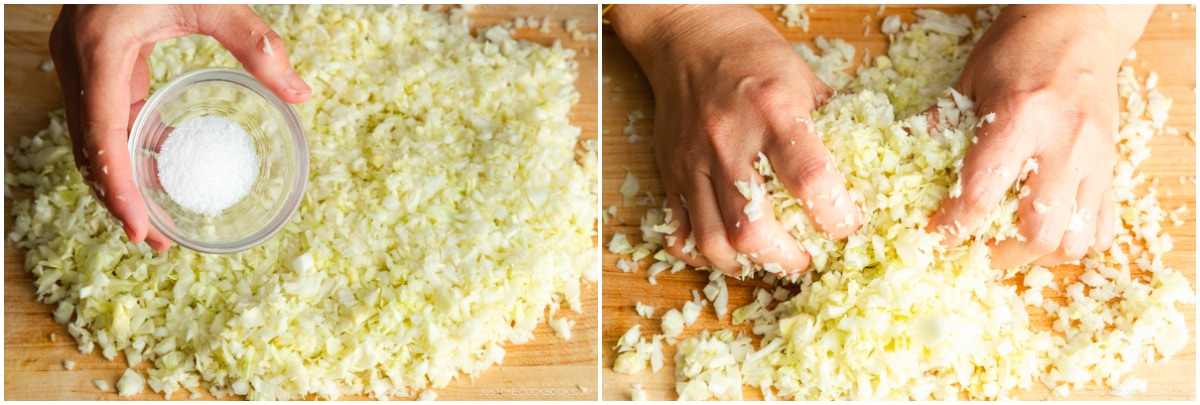
- Mince 2 green onions/scallions into small pieces.
![Gyoza 4]()
- Remove the stems from 2 shiitake mushrooms and mince the caps into small pieces.
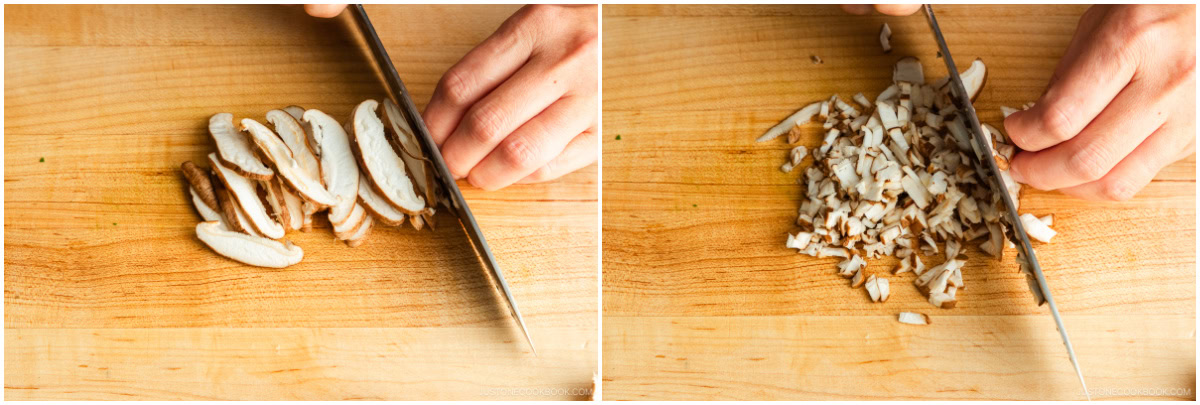
- Grate the ginger with a ceramic grater and add 1 tsp ginger (grated, with juice) to a small plate. Mince or press 2 cloves garlic (I use a garlic press) and add to the plate.
![Gyoza 7]()
- Combine the green onions, shiitake mushrooms, and ½ lb ground pork in a large bowl. Now, add the seasonings: 2 tsp sake, 2 tsp toasted sesame oil, 2 tsp soy sauce, and ⅛ tsp freshly ground black pepper.
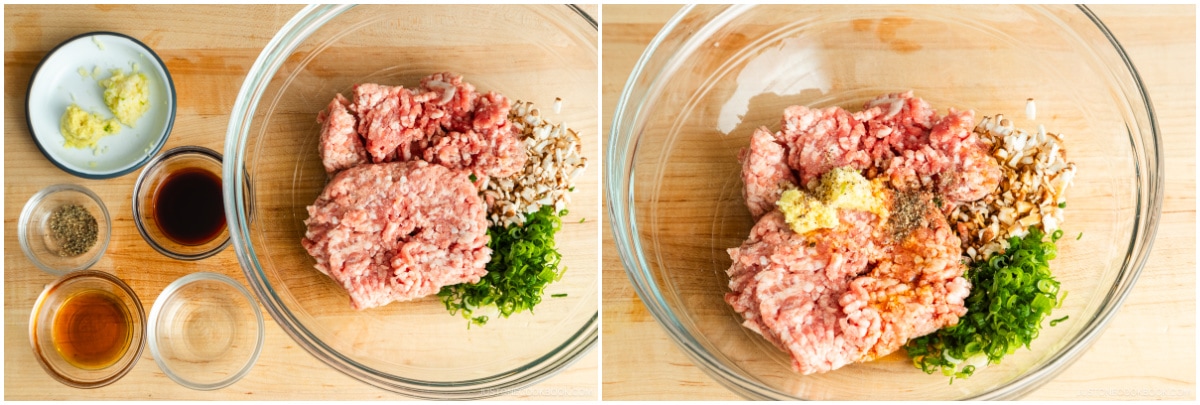
- Mix well and knead the mixture with your hand (I wear plastic disposable gloves) until it becomes sticky and pale in color.
![Gyoza 9]()
- Next, squeeze the water out from the salted cabbage and add to the meat mixture.
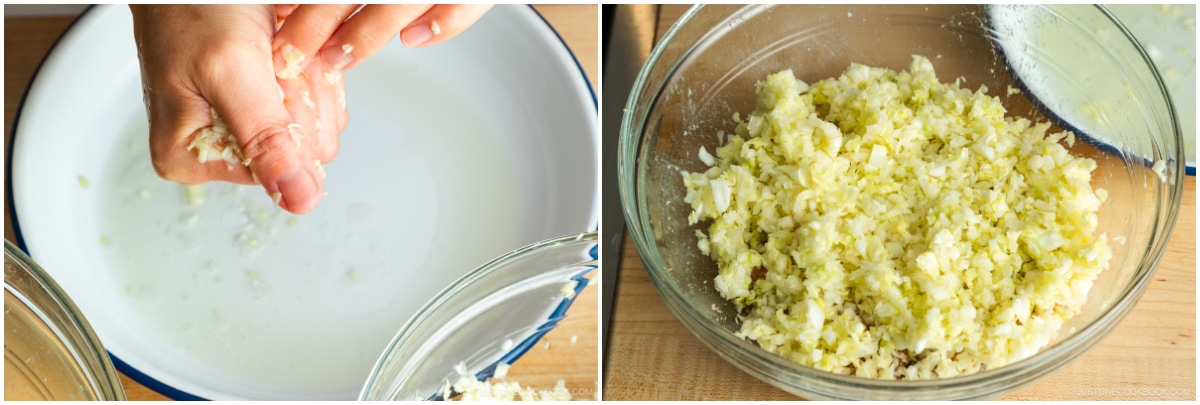
- Knead the mixture again with your hand to evenly distribute the cabbage into the meat.
![Gyoza 11]()
To Fold the Gyoza
- Prepare a small bowl of water and a baking sheet lined with parchment paper or dusted with 2 Tbsp potato starch (or cornstarch). Open 1 package gyoza wrappers and cover them with a damp towel or plastic wrap at all times so they don‘t dry out.
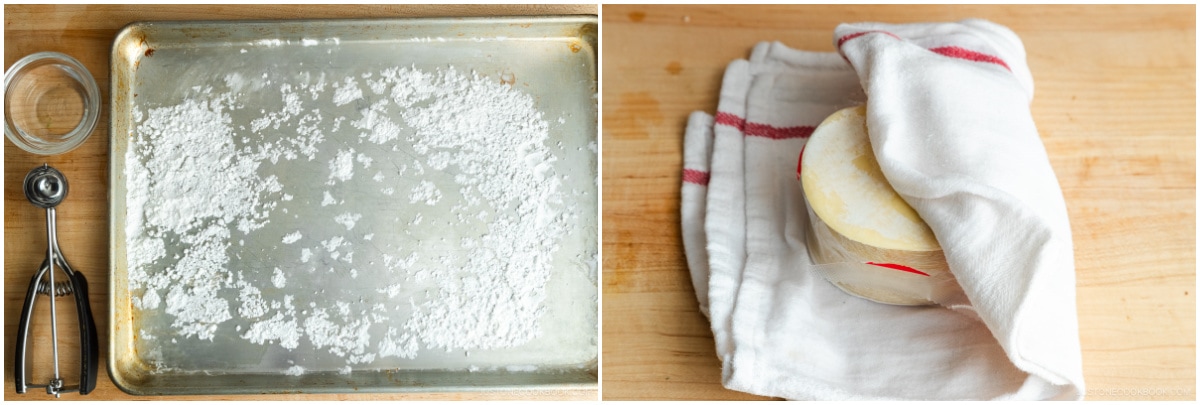
- Place a wrapper in the palm of your non-dominant hand (left hand for me). Use a small cookie scoop to place a scant 1 Tbsp or less of filling in the center. Do not overstuff. (If you‘re new to gyoza making, use ¾ Tbsp of filling.) Flatten it with the scooper bowl, making sure to press out any air pockets in the filling.
![Gyoza 13]()
- Dip one finger in the water and use it to moisten a circle around the outer ¼ inch (6 mm) of the wrapper. Fold the wrapper in half over the filling and pinch the two sides together at the top center, but don’t seal it yet.
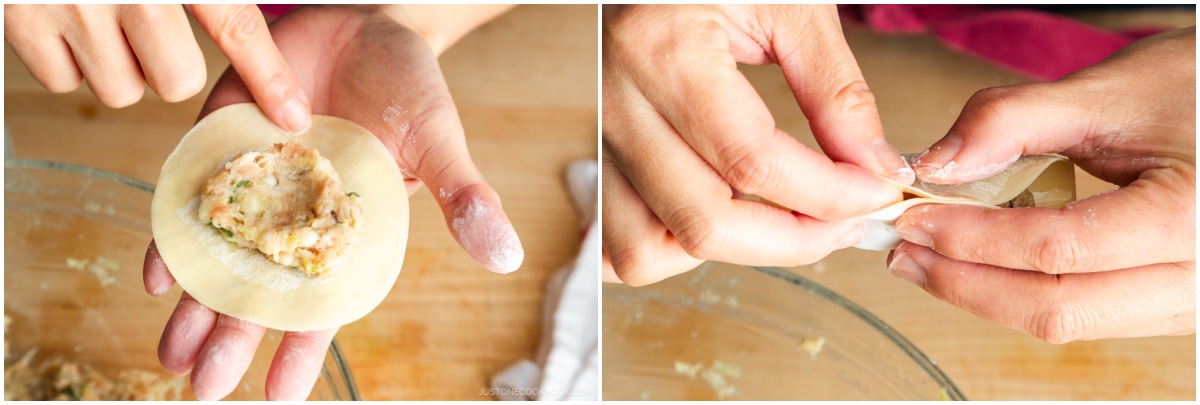
- In this recipe, I show you how to fold gyoza with the pleats leaning toward the center. If you want the pleats leaning toward one side, check out my How to Fold Gyoza post.
![Gyoza]()
- Start on the right side near the top center. To make the first pleat, use your right thumb and index finger to fold the wrapper‘s top half into a pleat that leans toward the center. Use your left thumb and index finger to press the folded pleat tightly against the back half of the wrapper.
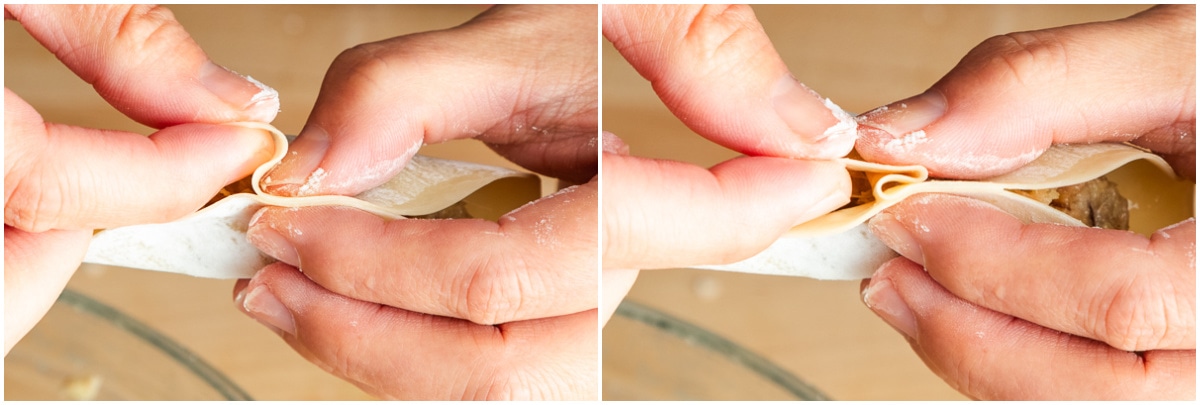
- Here is what it looks like from the front.
![Gyoza 15]()
- Repeat folding along the right side about once every ¼ inch (6 mm), making 3–4 pleats total.
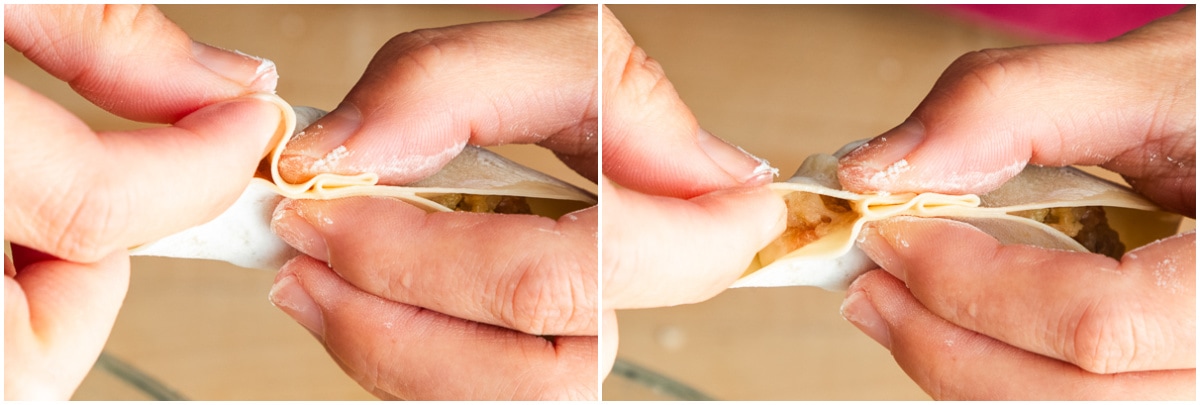
- Here what it looks like from the front.
![Gyoza 17]()
- Press down the pleats to seal any gap.
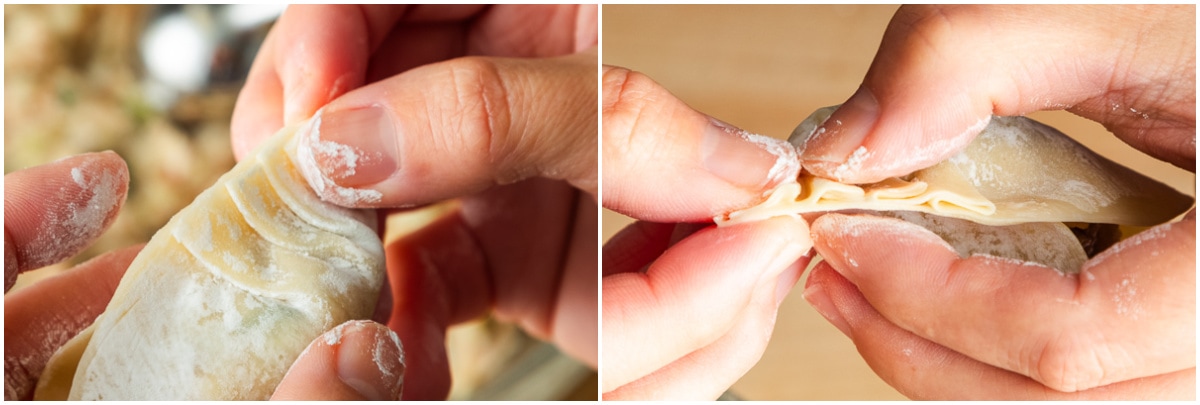
- Now, pleat the left side of the gyoza, starting near the top center. To make the first pleat, use your left thumb and index finger to fold the wrapper‘s top half into a pleat that leans toward the center. Use your right thumb and index finger to press the folded pleat tightly against the back half of the wrapper.
![Gyoza 21]()
- Here is what it looks like from the front.
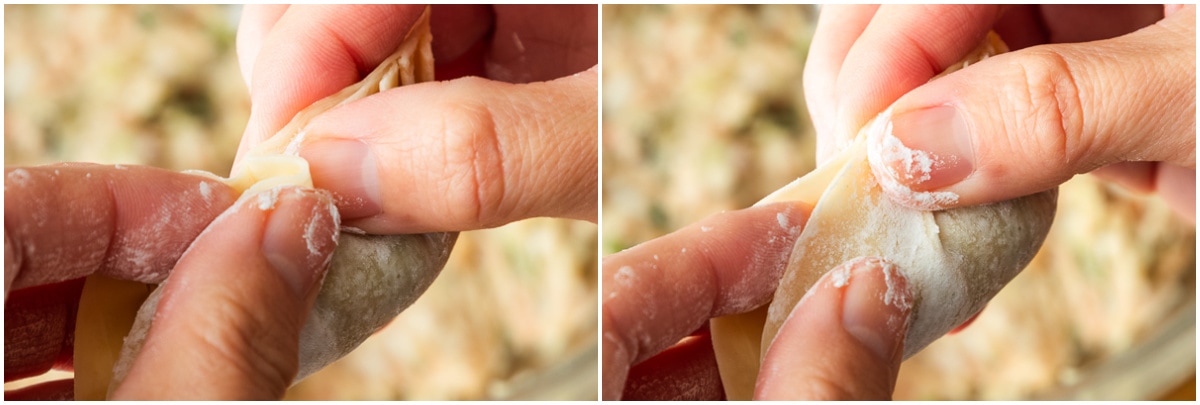
- Repeat folding along the left side about once every ¼ inch (6 mm), making 3–4 pleats total.
![Gyoza 23]()
- Here is what it looks like from the front.
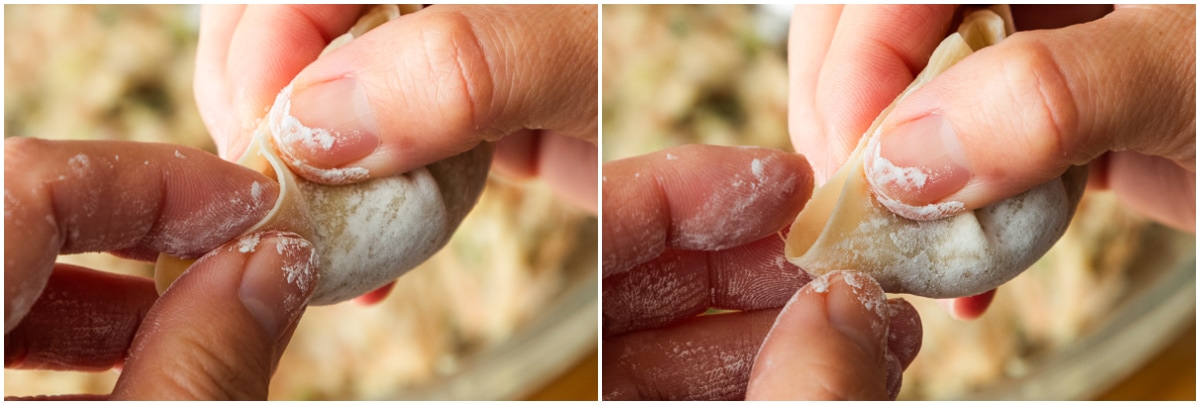
- Press the pleats one last time.
![Gyoza 24]()
- Evenly distribute the filling and shape the gyoza to create a flat side on the bottom.
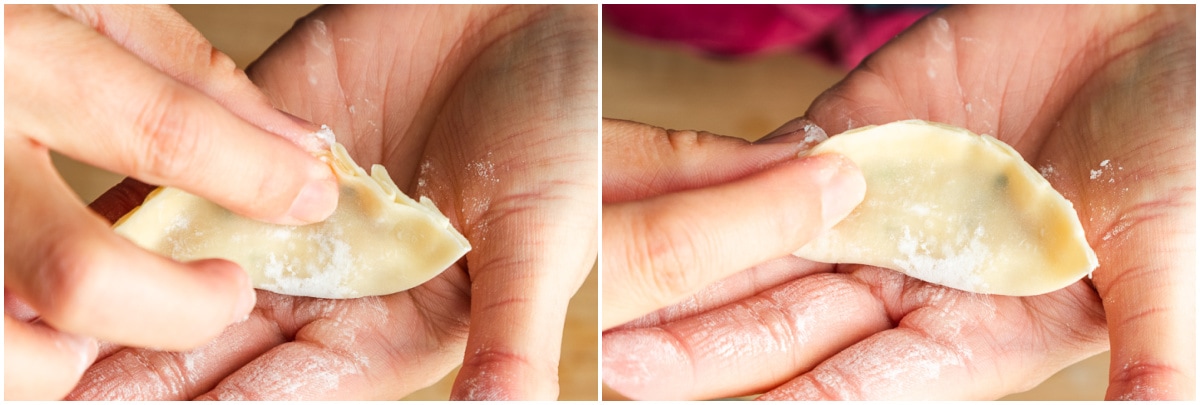
- Place your finished gyoza on the baking sheet and cover with plastic wrap to avoid drying. Repeat to fold the remaining wrappers.
![Gyoza 26]()
To Freeze Uncooked (optional)
- If you want to store uncooked gyoza to cook later (optional), now is the time to freeze them. Before the filling starts to release moisture and make the wrappers soggy, lay out the gyoza on a sheet pan or plate in a single layer so they‘re not touching. Then, cover with plastic wrap or a large resealable bag. Place the sheet pan in the freezer to flash freeze the gyoza until solid (or at least frozen on the outside).
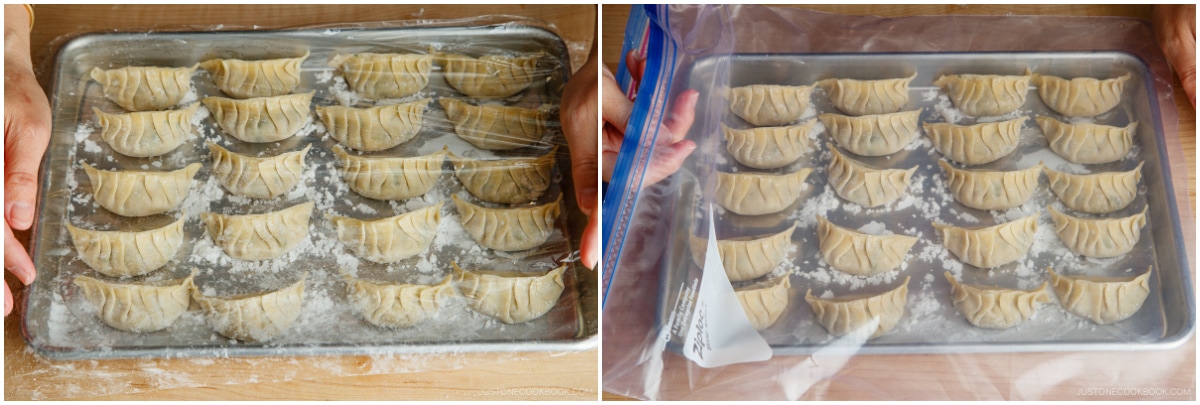
- Once the gyoza are frozen solid, pack them in an airtight bag. Because you flash froze them, the gyoza won’t stick to each other in the bag. Store the gyoza in the freezer for up to a month. When you’re ready to cook them, place the frozen gyoza directly in your frying pan. Follow the regular cooking instructions below, but steam them for an extra 1–2 minutes.
![Napa Cabbage Gyoza 22]()
To Cook the Fresh Gyoza
- Cook the gyoza in batches or use two frying pans. First, dust off any potato starch from the gyoza bottoms using a pastry brush.
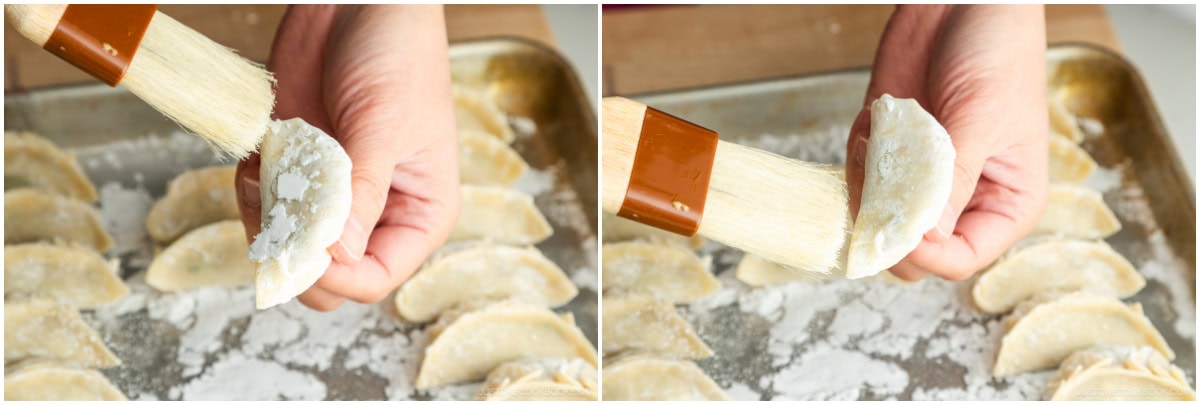
- Heat a large nonstick or carbon steel frying pan over medium heat (I use an 11" carbon steel pan). When the pan is hot, add 1 Tbsp neutral oil. When the oil is hot, place the gyoza in the pan, flat side down. Arrange them in a single layer in a circular pattern, and leave space between each piece so they don‘t touch.
![Gyoza 33]()
- Alternatively, you can arrange them in one or two rows. Leave space between each piece so they don‘t touch each other.
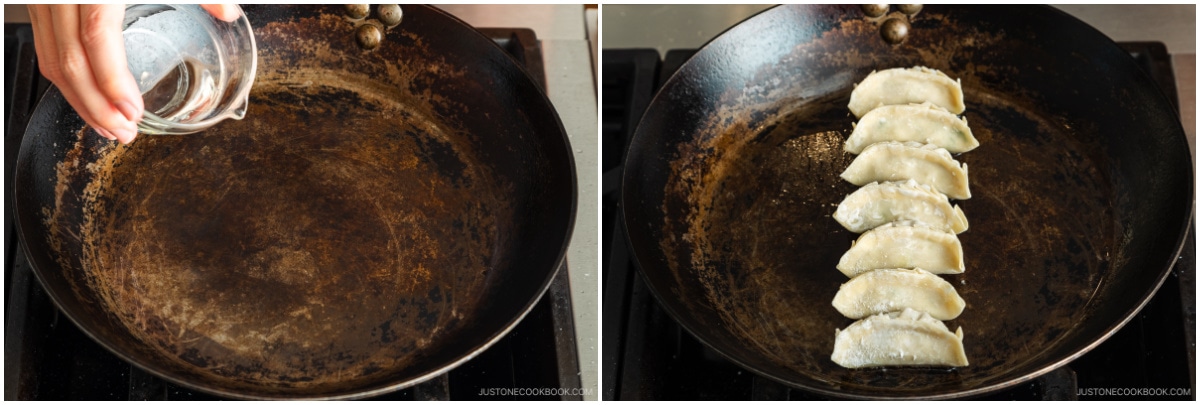
- Cook until the bottom of the gyoza turns golden brown, about 3 minutes. Then, add 4 Tbsp water to the pan and immediately cover with a lid.
![Gyoza 34]()
- Steam the gyoza for about 3 minutes or until most of the water evaporates. Tip: If you‘re cooking frozen gyoza, steam them for an extra 1–2 minutes.
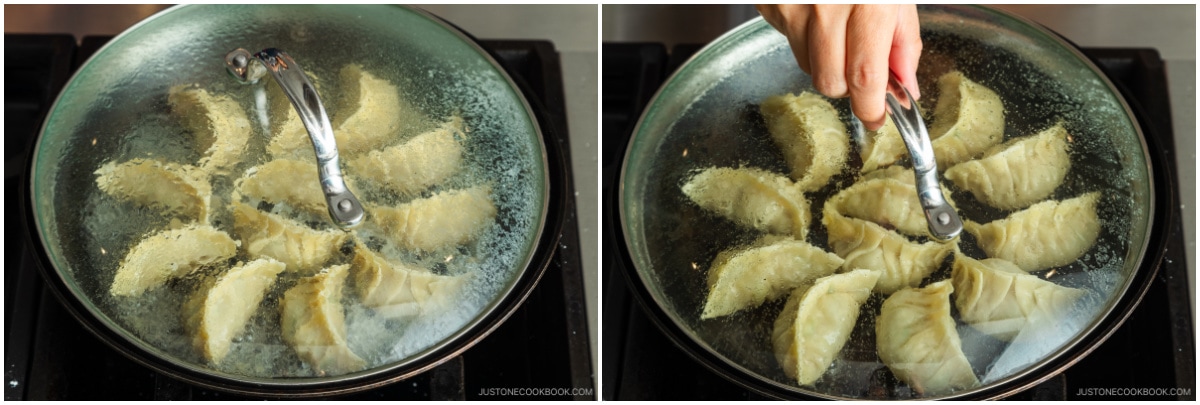
- Remove the lid to evaporate any remaining water. Drizzle 1 tsp toasted sesame oil around the gyoza in the frying pan. Cook, uncovered, until the gyoza is browned and crisp on the bottom.
![Gyoza 36]()
- Remove to a plate. Repeat the process to cook the other batches.
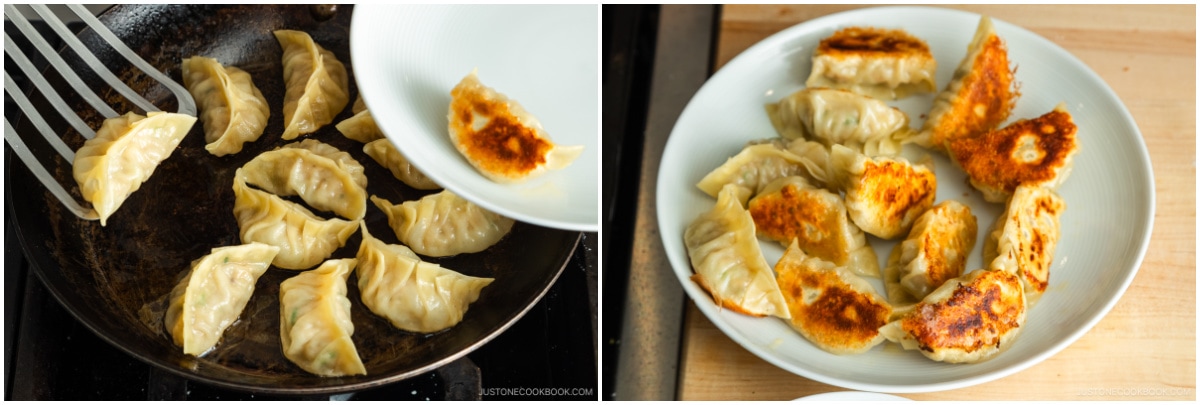
To Serve
- Transfer to a serving plate and serve with individual bowls of dipping sauce on the side. For each individual serving, combine 1 Tbsp rice vinegar (unseasoned), 1 Tbsp soy sauce, and the optional ⅛ tsp la-yu (Japanese chili oil) in a small dipping bowl and mix together. Enjoy!
![A round plate containing gyoza (Japanese potstickers or pan-fried dumplings) with a small plate of dipping sauce made with soy sauce, vinegar, and Japanese chili oil.]()
To Store
- Leftover cooked gyoza: Cool, transfer to an airtight container, and store in the refrigerator for up to 3 days or in the freezer for a month.
- Leftover filling: Make mini meatballs or patties and cook them in a frying pan. Once they are pan-fried, you can cool them, pack in an airtight container, and store in refrigerator or freezer for later use.
- Leftover wrappers: You can fill each wrapper with sliced cheese, fold in half, and press to seal. Pan-fry until golden on both sides. They are a favorite with kids!
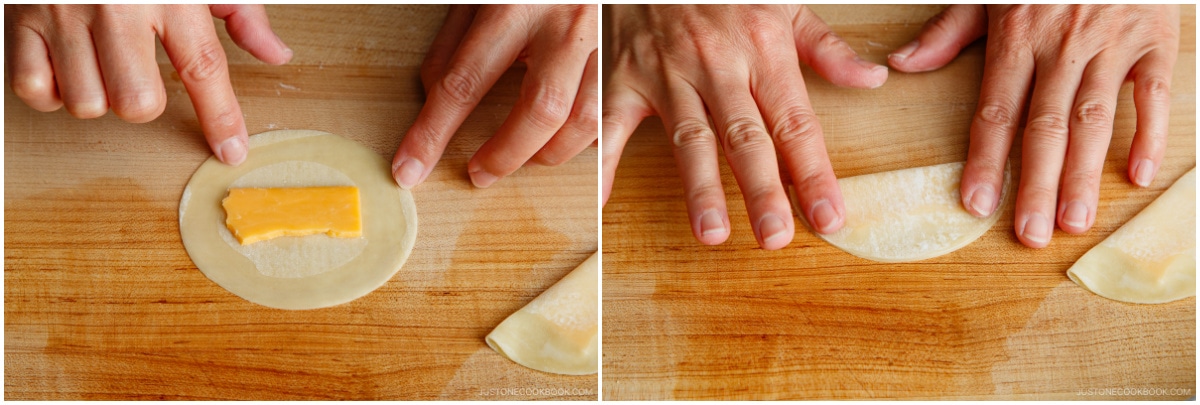
Nutrition
Calories: 38 kcal · Carbohydrates: 3 g · Protein: 2 g · Fat: 2 g · Saturated Fat: 1 g · Cholesterol: 5 mg · Sodium: 49 mg · Potassium: 27 mg · Fiber: 1 g · Sugar: 1 g · Vitamin A: 6 IU · Vitamin C: 1 mg · Calcium: 3 mg · Iron: 1 mg Course: AppetizerCuisine: JapaneseKeyword: gyoza, pot sticker ©JustOneCookbook.com Content and photographs are copyright protected. Sharing of this recipe is both encouraged and appreciated. Copying and/or pasting full recipes to any website or social media is strictly prohibited. Please view my photo use policy here.
Editor’s Note: The post was originally published on Feb 9, 2011. It was updated with new step-by-step and final images and the slightly revised recipe on April 13, 2024. It was republished with more information in the blog post on January 23, 2025.


